
















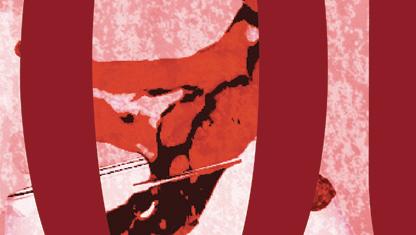













































































Whistler and Vancouver
will not relive their Olympic glory in 2030 after the province declined to support an Indigenous-led bid.
15 YOUR WORSHIP Whistler’s new mayor and council were officially sworn into office at the Maury Young Arts Centre on Tuesday, Nov. 1.

A deferral on old-growth logging in the Cheakamus Community Forest remains in place, for now, as officials plot their 2023 harvesting plans.
The Squamish-Lillooet Regional District will stick to its original route as it looks to complete the Sea to Sky Trail from Whistler to Pemberton.

The COVID-19 pandemic led to lasting changes for the bike coaching industry in Whistler and beyond.
Author Cathalynn
Labonté-Smith’s new book offers search-and-rescue lessons for adventurers across British Columbia.
COVER Safe to say this is the best month of the year to just wine on and on and on! - By Jon Parris // @jon.parris.art





























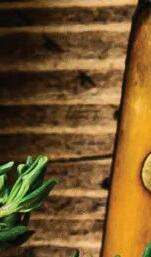























































938-0201

KATHY
BOB BARNETT
SARAH STROTHER - sstrother@wplpmedia.com
Editor BRADEN DUPUIS - bdupuis@piquenewsmagazine.com
Manager SUSAN HUTCHINSON - shutchinson@wplpmedia.com
Manager AMIR SHAHRESTANI - ashahrestani@wplpmedia.com
Art Director JON PARRIS - jparris@wplpmedia.com
Representatives
TESSA SWEENEY - tsweeney@wplpmedia.com
GEORGIA BUTLER - gbutler@wplpmedia.com
Digital/Sales Coordinator AMELA DIZDARIC - traffic@wplpmedia.com
Production production@piquenewsmagazine.com
Features Editor BRANDON BARRETT - bbarrett@piquenewsmagazine.com
Arts Editor ALYSSA NOEL - arts@piquenewsmagazine.com
Social Media Editor MEGAN LALONDE - mlalonde@piquenewsmagazine.com
Reporters
BRANDON BARRETT - bbarrett@piquenewsmagazine.com
MEGAN LALONDE - mlalonde@piquenewsmagazine.com
ALYSSA NOEL arts@piquenewsmagazine.com
ROBERT WISLA - rwisla@piquenewsmagazine.com
Classifieds and Reception mail@piquenewsmagazine.com
Office and Accounts Manager HEIDI RODE hrode@wplpmedia.com
Contributors G.D. MAXWELL, GLENDA BARTOSH, FEET BANKS, LESLIE ANTHONY, ANDREW MITCHELL, ALISON TAYLOR, VINCE SHULEY, LISA RICHARDSON
President, Whistler Publishing LP

SARAH STROTHER - sstrother@wplpmedia.com
08 OPENING REMARKS Whistler’s new mayor and council were officially sworn into office on Nov. 1. Where should they focus their efforts first?
LETTERS TO THE EDITOR Letter writers this week call for more public engagement in Whistler, and wonder about Vail Resorts’ hiring practices as they relate to housing.
PIQUE’N YER INTEREST Where is the line when it comes to tipping? Columnist (and parttime server) Megan Lalonde weighs in.
58 MAXED OUT Max returns to civilization, somewhat reluctantly, to find that very little has changed here in the real world. Oh well.
29 RANGE ROVER How did Canada come to its current political crossroads? That water has been boiling for some time, writes Leslie Anthony.
36 FORK IN THE ROAD As world leaders convene for COP 27, Glenda Bartosh takes the local temperature with some environmentally-minded Whistlerites.
MUSEUM MUSINGS In the early days of Whistler, one car was renowned for its ability to navigate the snow: the Volkswagen Beetle.
























BY THE TIME you read this, all the pomp and circumstance will have taken place, and Whistler’s new local government will be official.
So now it’s time to put our newly elected officials to work.
The campaign that just concluded was not overly contentious, but it did contain a few key themes which should not be ignored in the weeks and months to come.
BY BRADEN DUPUISChief among them are issues related to housing, affordability, and health and well-being.
All represent complex challenges, none of which will be solved overnight or with a single, simple policy shift.
But as our new council sets its four-year workplan, here are just a few of the things we think it should focus on.
It was pointed out to Pique recently, after it was learned that the Whistler Valley Housing Society (WVHS) is in early talks to buy one of the as-yet-unbuilt apartment buildings in Cheakamus Crossing Phase 2, that there is a sizeable gap in Whistler’s housing policy.
Presumably, the deal would allow the WVHS to house participants in Zero Ceiling’s Work 2 Live program, and other vulnerable, underserved segments of the local population.
But while the discussion is still in its infancy, without a proper municipal policy in place for such things as social housing, any such deal is premature.
It’s true that Whistler has had great success, through the Whistler Housing Authority, in housing its workforce locally over the years. But it is also true that many people are underhoused, or have already
been forced out of the community.

As far as Whistler’s housing policy goes, social housing represents a significant gap.
Some might disagree, and argue that municipalities shouldn’t dabble in housing at all; Some might actually prefer it that way.
But our new mayor and council should take this challenge head-on. Keep building housing, yes, but also make a firm commitment to fix local policy, wherever it needs fixing. That could be shoring up data collection, creating new policies focused on living standards and vulnerable populations, or tweaking existing policies to ensure the best use of our local inventory.
Yes, housing is challenging everywhere. But that doesn’t mean we should turn our backs to indignities happening in our own community while we wait for someone else to solve our problems for us.
It’s time to ask the hard questions and confront the hard truths about housing in Whistler.

a community-governed, collaborative primary care service in Whistler.

Last fall, the collaborative detailed its ambitious vision for a primary care centre that would dramatically transform healthcare delivery in the resort. The centre is aimed at improving physician accessibility and offering a more holistic care model that would include general practitioners, nurse practitioners, and a range of other healthcare professionals under one roof.
Dr. Karin Kausky, vice chair of Whistler 360, said the group plans to begin formal operations in January.
“We are looking forward to working with mayor and council on securing expanded space that will allow us to grow the number of providers, to ensure everyone in Whistler has access to primary care,” Kausky said in an email, adding that the Whistler 360 board is very grateful for all the support it has received so far.
I know it likely doesn’t need to be said,
would open so many doors for corridor residents in terms of access to housing, jobs, health-care and more. It would also improve traffic congestion, and reduce greenhouse gas emissions.
Our local leaders know this. The province knows this. And yet…
A study released in 2017 pegged the costs to get regional transit up and running at about $3.31 million—with $1.9 million of the spend to be split amongst six local governments.
Inflation and rising fuel costs will have pushed that estimated spend much higher here in 2022, but it still seems so marginal when you take the broader picture into consideration: six local governments, a relatively minor expenditure, and massive, immediate benefits.
Why are we sitting on our hands, here, exactly? Clearly the strategy of waiting for the province to take pity on us isn’t working. Get it done already.

Lastly, we hope our new council takes very seriously the impacts of inflation and unaffordability on local residents—because expenses keep increasing across the board, and new fees just keep piling up.

A close second behind housing in terms of local priorities, Whistler locals need longterm health-care solutions, and they need them fast.
It is now estimated that 1 million British Columbians do not have a family doctor, and with Town Plaza Medical Clinic’s closure in May of this year, it’s safe to say a fair number of Whistlerites fall under that category.
Luckily, the resort is blessed with a team of passionate, dedicated health-care workers who are leading the charge on finding answers through the Whistler 360 Health Collaborative, a non-profit working to develop
but if there is anything our new mayor and council can do to expedite this process, it should be among the first orders of business after inauguration day.
Pique has been beating this long dead horse almost as long as local officials have been asking provincial leaders to step up to the plate with funding.

But it bewilders us that the Sea to Sky still does not have regional transit.
Having buses running regularly from Mount Currie to the Lower Mainland
The announcement last month that Marketplace will no longer offer a free hour of parking was just another kick in the gut for downtrodden Whistler locals.
Even if a young person can find a place to live in Whistler this winter, they’ll break the bank just trying to make ends meet.
Keeping in mind that nothing is ever free, can Whistler do more to ease the pain for locals? Could council, during its upcoming budget deliberations, shift some spending at muni hall to offer some small relief in the way of local parking passes in the village or at our parks? Or perhaps free bus passes for locals?
It’s not much, but every little bit helps when you’re living paycheque to paycheque. ■





The dust has settled. Lawn signs gone; allcandidates meetings a faint memory. Now all that’s left is the swearing-in of council, then reality and all the hard work kicks in for the next round of municipal politics—the level of government that affects us the most but seems to attract us the least.

As the latest election cycle fades, there’s still one thing I can’t get out of my mind—your Opening Remarks in the run-up to the election in the Sept. 29 Pique: “The loneliest job in Whistler.”













My heart broke reading that, then it broke again when I saw the online version with that haunting photo by Dave Buzzard. It shows one intrepid and very lonely reporter (you?) and one other lonely soul in a sea of empty seats at a Whistler council meeting.





I can promise you, and so can hundreds of others, that the 2011 election wasn’t the only time people got involved big-time in Whistler’s civic affairs.
For five years I worked—hard—at the Whistler Question, Whistler’s first newspaper. Ironically, its fifth anniversary issue was my first as a cub reporter, who covered council. Its 10th anniversary was my last, as the youngest publisher in Canada and one of only three women who owned a newspaper.

The Question was about five years younger







than the Resort Municipality of Whistler, and council meetings in the early municipality were usually packed to the gills with those peanut gallery rabble-rousers you describe. They— both the meetings and the rousers—were more entertaining than after-hours at Tapley’s. There was even more than one reporter on hand, from The Question, The Squamish Citizen, Mountain FM, and maybe even a rouser or two from The Whistler Answer
People had a stake in their community. And guess what? They still do, as does everyone who lives in a democracy. I’m not sure what’s happened that people feel like they don’t.
Sure, that was the ’80s and the village was just taking shape. But people, regular people—old ones, young ones, busy ones and just plain busy-bodies—had spent hours and more hours thinking, planning, yakking, and debating what Whistler would be long before then. Sometimes it was exciting and sometimes it was plain boring, but that’s democracy.
I remember one day out of the blue, our instructor at journalism school flabbergasted us. “So you know that journalists are just frustrated politicians,” he said. “No way!” we protested, outraged. “We’re there to keep them in check!”
Maybe it’s both. Either way, I took a run at office. Twice, in the early 2000s, and the only reason why was climate change. It scared the crap out of me then, and scares me even more now. I didn’t get in. Close—only 47 votes away—but no cigar. Tell me again how your vote doesn’t matter.




I’d been on dozens of civic committees, went to countless council meetings, and— being really old-school in thinking that one should be prepared for such a responsibility— read tons of books and articles on politics and democracy and civil society and civic engagement. One thing stuck out like that “loneliest job in Whistler.”
It was in an essay on U.S. history in Harper’s Magazine, one of the best publications on the planet: People living in the Thirteen Colonies in early America spent an average—repeat, average—of 12 hours a week on civic affairs.

Think about it! Twelve hours a week! About half the time the average Canadian today spends each week watching TV or videos. That would be, like, one or two evenings a week and maybe all day Saturday, working with your neighbours to decide where to put the new school, where you were going to redirect the local stream, or how wide to build the new path.
Democracy is an activity, and everybody pitched in.
Like your editorial, and so many others have said, the politics of engagement—the politics of democracy—is dying. It’s being replaced by the politics of grievance—a remote, reactive approach fuelled by complaining. Even in 2011, when Pique readers said the most sustainable


thing Whistler did was “electing a new council,” that was the politics of grievance. Ditto the low grumble in the back of the room today.
So remember what Winston Churchill said in 1947, two years after Hitler and Mussolini were defeated: “Democracy is the worst form of Government except for all those other forms that have been tried from time to time...”
There’s something eternally sad and, worse, dangerous, about “giving over” political power because you can’t be bothered, then taking the passive-observer path until you get really pissed off and vent (anonymously?) on social media.

The election—pffft, it’s history. Now the real work begins, and the more hands on deck the better, whether you’re running a farm, a resort town, or a nation.
I really hope people don’t just sit back and wait four years to vote—maybe. I really hope that Whistler’s council chamber—every council chamber—is packed every meeting with people wanting to pitch in. There’s so much important work to do—the climate file, the housing file, parks, and more.
Imagine if every local spent 12 hours a week working on it—kids, teenagers, old rabble-rousers, everyone. I hope they add their two cents’ worth when they get a good idea, and when they get a lot of good ideas, they run for office one day and see what happens.
Democracy is so uncool it’s cool. But it only works when you’re not the only one in the echoing chamber.
Glenda Bartosh // Vancouver







I recently applied for a job at Whistler Blackcomb (WB). Part of the application process involved answering a series of questions about myself, and at the end of it I received, to my surprise, a job offer, even though I hadn’t spoken to anyone.

I was invited to attend an online meeting to receive more information about the job. I also applied for staff housing. I had received an invitation several months before to apply for staff housing, but hadn’t, as I didn’t have a job offer at the resort. During the online meeting, I found out that staff accommodation was
full, and that only one person in the meeting actually had accommodation in Whistler.
We were told to “find accommodation after we arrived in Whistler.” I wasn’t sure if that meant we were supposed to come to Whistler and sleep in a car until we found accommodation, or stay in a hotel, or sleep on a friend’s couch, or what. At the time, I assumed that my manager would request that I be placed on a waiting list for staff accommodation, but I later found that that wasn’t true, so I had to ask for that to be done.
After that, I received an email asking me when I was arriving in Whistler. A couple of days ago, I received another email about finding non-staff accommodation in Whistler. The email advised that I join a Facebook group dedicated to finding accommodation in Whistler, but I found that the group was full of desperate pleas for accommodation from people who like me had been offered a job in Whistler but who had no accommodation there.
It is hard to overstate the bizarreness of this whole experience… Why would a company offer jobs to all of these people who have no accommodation in a town experiencing an extreme housing crisis?
Chris Brossard // Whistler

On Oct. 22, Whistler Search and Rescue welcomed back 100 guests at Dusty’s in Creekside for our annual “Wine’d Up” fundraiser. Guests enjoyed a gourmet dinner paired with exquisite wines from International Cellars and delicious food created by Araxi, Il Caminetto and Fairmont Chateau Whistler.
This year’s fundraiser was very important, as it served to help us equip and train our new cohort of 14 members in training. We are honoured to have added this talent to our team.

In addition, our search-and-rescue callouts are increasing, and the need to be able to conduct searches after dusk has become increasingly important. Gear, such as nightvision helmets and goggles, allows us a higher degree of successful outcomes for both the subjects and our members.
The funds raised on this special evening

allowed us to fully equip and train our 14 members and direct funds to the acquisition of a new set of night-vision goggles.
We raised $120,000—an astounding amount that has surpassed our expectations, and the highest result since we started this event 23 years ago.
Our success couldn’t have happened without the extraordinary sponsorship from the community and the wonderful donations from more than 80 businesses and personal contributions to our silent and live auctions.


A special thank you to our event volunteers, Sharon Tyrrell, Sue Stafford, Rosemary Cook, Georgina Titus, Corinne Cowden and WSAR members who made this evening an unforgettable experience for all.
Janice Hulse and Brad Sills // Whistler Search & Rescue Society




Thank you to everyone who took part in the 39th annual Tapley’s Farm Halloween festivities. Our neighbourhood once again pulled out all the stops—from the artistically carved pumpkins to the themed houses and fabulous costumes—to welcome more than 1,000 local children and parents to trick or treat.
Special thanks as ever to Bruce Stewart and Nesters Market for sponsoring the spectacular fireworks display, hot chocolate, and their generous candy donation. We also greatly appreciate all the candy donations from Fresh Street Market, Your Independent
Grocers, Creekside Market, the Grocery Store, and everyone who donated at our collection boxes around town.
Thanks to the Whistler Fire Association and its members for safely igniting the fireworks and handing out hot chocolate; the RCMP for their ongoing support; and to BC Transit, Whistler Marketplace, fastPark and the RMOW for organizing the free Goblin Shuttle, and to the Whistler Waldorf School for decorating the bus. Also thanks to Pique Newsmagazine and Mountain FM for your promotional support.
A big shout out to the Whistler Secondary School Leadership Team and the 25-plus enthusiastic volunteers coordinated by acting principal John Hall for manning the entrance and organizing the “We Scare Hunger” campaign for the Whistler Food Bank. A huge thank you to the Whistler Community Foundation for the $500 Neighbourhood Grant to support the campaign and entrance, and to Whistler Balloon Works for the display.
Together, we raised a record $1,385 in cash and 252 kilograms of food for our Whistler Food Bank.


It was encouraging to see so many people, kids and families, dressed up, and that we were able to gather again to celebrate Whistler’s longest-standing community tradition. Our Whistler spirit is alive and well in Tapley’s Farm neighbourhood! See you next year for our 40th edition!
Amanda Wilson & Shauna Hardy // On behalf of Tapley’s Farm Neighbourhood n




I WAS LISTENING to a podcast recently when I heard a few phrases that struck me to my core.
I’ll plunge into a pond of crocodiles where I’ll be torn limb from limb.”

Maybe “struck me to my core” was a little dramatic, but I fully related to the sudden-onset, pressure-induced panic when the iPad flips around and you’re calculating in your head just how big of a tip the sandwich and kombucha or latte and take-home bag of coffee beans you’re purchasing warrants.
helps support locals making it work in this town—we all know wages haven’t necessarily crept up at the same rate inflation has. Is it always necessary? Maybe not, some argue, but aside from another few dollars out of my account there’s no real downside, plus it’s better safe than sorry, in the event servers need to tip-out a portion of their takeout sales. And, as a service worker myself, I fully believe in tip karma.
but I’d guess takeout tips would follow a similar trend.
The podcast is called Flightless Bird, hosted by a journalist named David Farrier. The self-proclaimed “New Zealander who ended up accidentally marooned in America” delves into a series of American (more often North American) customs that aren’t as common elsewhere.
BY MEGAN LALONDEFor example, tipping. It wasn’t so much the host’s confusion about what to do when the bill comes at a restaurant that resonated— I’d like to think that after about a decade spent serving and bartending part-time, I’ve got that one dialled—but about what to do when you’re standing at a counter.
“I stand in line in a café to pay for a coffee, and I’m presented with a giant, illuminated screen requesting a tip,” Farrier explains in the episode’s introduction. “The barista and the line of customers watches on as my finger hovers over the screen: 15 per cent or 25 per cent? I feel like I’m on a game show and if I pick the wrong option, the floor will drop out from under me and
Clearly, I’m not alone in questioning what the etiquette is these days. A post in the Whistler Winter Facebook group last week posed the question. “Takeout: to tip or not to tip?” It netted 170 answers and, as usual, sparked some fairly fierce debates about the pros and cons of tipping as a practice, without a whole lot of consensus.
Among the topics disputed: do tips represent a service charge that you shouldn’t need to pay if you’re not receiving table service throughout the meal? Or does someone sourcing, preparing and packaging the food that you pick up still count as service, in that context? What does the tip-out structure look like in takeout settings?
Like a lot of commenters on that thread, I find tipping prompts popping up more often, too, but I’ll still tip in almost every situation where it’s an option, even if I tend to leave a little less for quick counter service than a two-hour, sit-down meal.
I mostly view it as a gesture that hopefully
But like most people in their twenties who live in Whistler and work two jobs, I still need to be at least somewhat fiscally responsible. My struggle is with figuring out just how much is appropriate in those greyer areas.


During the pandemic, when takeout was the only option if you wanted to eat something that wasn’t prepared in your own kitchen, it seemed like society generally rallied behind front-line workers, recognizing the heightened impact pandemic restrictions had on the industry and raising tips accordingly. Are those inflated numbers—and, maybe, expectations—sticking around now that those restrictions are gone?
Probably, it appears. A survey conducted by Restaurants Canada in April 2022 found 44 per cent of Canadians surveyed reported leaving higher tips when dining out compared to pre-COVID. The survey related specifically to table-service,
A less-scientific poll conducted on Pique’s website this week asked readers how much they normally tip on takeout or counter service. Just under a quarter of respondents said they typically don’t tip; while 12 per cent of respondents leave five per cent of the cost. A 10 per cent tip was the most popular option, selected by 33 per cent of respondents, while 22 per cent of respondents said they tip 15 per cent; three per cent usually leaving an 18-per-cent tip and five per cent normally tipping at least 20 per cent.
Say what you will about North American tipping culture—yes, there are some worthy arguments to abolish it, but I think we can agree it is too entrenched of a cultural practice to change anytime soon—at the end of the day, it’s still technically optional.
Deciding whether to tip the person making your latte five per cent or 10 per cent or 15 per cent or 20 per cent or 30 per cent is probably not as awkward as both I and David Farrier make it out to be, and realistically, there’s no pool of crocodiles waiting to snap up customers if they choose the wrong option. Spend your money however makes you feel most comfortable. Just maybe put yourself in the shoes of the server or kitchen worker who’s packing up your to-go order first. ■
EFFORTS TO BRING the Olympic and Paralympic Winter Games back to Whistler and Vancouver in 2030 are over.
Lisa Beare, Minister of Tourism, Arts and Culture, announced on Oct. 27 that the province would not support a 2030 Olympics in B.C., killing the bid in its tracks less than one year after four First Nations, together with the Resort Municipality of Whistler (RMOW) and City of Vancouver, announced plans to explore the feasibility of hosting the first-ever Indigenous-led Games. The Canadian Olympic Committee (COC) and Canadian Paralympic Committee (CPC) officially came onboard in January.
“We entered the process believing in the vision shared by the Lil’wat, Squamish, Musqueam and Tsleil-Waututh [First Nations],” said Whistler Mayor Jack Crompton in a written statement to Pique on Tuesday, Nov. 1.
“It is disappointing to see our efforts, and the effort of the many parties who invested in this process, come to an early conclusion. With this said, the energy and care we have put in is not lost. As a result of this work, we now share a much deeper connection with both the Lil’wat Nation and Squamish Nation. We also have a better understanding of how we can approach our role in ensuring reconciliation remains at
the forefront in everything we do.”
In the statement, Crompton thanked Tourism Whistler, Whistler Blackcomb, the community and RMOW staff for their contributions to the bid exploration and invited those groups to continue, “upholding our commitment to reconciliation.”
Crompton joined leaders from the four Host First Nations, the CPC and the COC on Friday, Oct. 28, for an hour-long media briefing held in response to the province’s decision. The briefing took place at the BC Sports Hall of Fame in Vancouver.
First Nations leaders in attendance Friday expressed not just disappointment
discussions with the province. “We’re saying that we’re still here to have that conversation,” he said. “We want meaningful dialogue. If we want true reconciliation, we need to be in the room talking ... as an equal voice.”
Lil’wat Nation Chief Dean Nelson was unable to attend the briefing. (Pique reached out to the Nation for a comment on the province’s decision for this story, but did not receive a response before deadline.)
Beare said B.C.’s NDP government declined support for the bid after carefully weighing its costs, risks and potential benefits with current priorities like health-care, education, public safety, and

said the four Host First Nations initially approached the province a year ago to inquire about support for a 2030 bid. Beare said her office received an official proposal from the feasibility team “in the past two weeks,” alongside a request for a letter of support needed to enter into targeted dialogue with the International Olympic Committee, the next stage ahead of submitting a formal bid.
The four Host First Nations, the COC, the CPC and municipalities “mounted what is an incredible bid—the first First Nations-led bid—and it’s a model that truly deserves to be applauded,” Beare said. Denying it support was “a difficult decision,” she added.
“Cabinet reviewed that proposal and cabinet made a decision that ultimately the $2 billion in direct costs and risks were just far too great, and we would not be able to pursue the bid at this time,” she explained. Beare said she met with the Nations last Monday, Oct. 24 to relay the decision, and “provided an opportunity for them to meet with me in person to discuss that if they wish.”
with the province’s refusal to support what COC president Tricia Smith called “a responsible bid,” but frustration with what they described as a lack of consultation prior to that decision being made and a direct hit to reconciliation.
“True reconciliation was never acted upon,” said Squamish Nation Councillor Sxwíxwtn Wilson Williams during the briefing. “We were suffocated from a true colonial process.”
Wilson acknowledged “the omission of support from the governments would kill the bid,” but left the door open to re-igniting
affordability. B.C.’s existing commitments to host the Invictus Games in 2025 and the FIFA World Cup the following year also factored in, she said.
A business proposal submitted to the B.C. government reportedly sought $2.12 billion in cash and in-kind public funding to stage the Olympics. Half of that would have come from the federal government, while the province would also have been saddled with underwriting any deficits resulting from the Games.
During question period in the B.C. Legislature on Monday, Oct. 31, Beare
Her clarification came in response to questions from numerous BC Liberal MLAs Monday, including official opposition house leader Todd Stone, who framed the decision as premier-designate David Eby’s alone.
“First Nations had actually written to the incoming premier,”—who was a staunch opponent of the 2010 Games, recalled Stone—“and urged him to meet with them to discuss any concerns that he might have with the bid. And the respect they were shown by the incoming premier was not to get back to them, not to meet them, and then to have the rug pulled out from underneath them.”
The decision was made collectively by cabinet, rebutted Beare.
“[W]e now share a much deeper connection with both the Lil’wat Nation and Squamish Nation.”
- JACK CROMPTON
Whistler into what it is today.
BY ROBERT WISLAFOUR YEARS AGO, Mayor Jack Crompton stood at the podium in the Maury Young Arts Centre’s theatre, and predicted in his first address as mayor that in 2022, Whistler would elect its first born-and-raised resident to office.
“On Oct. 15, Whistler elected that person,” Crompton said in his second inaugural address at the Maury Young Arts Centre on Tuesday, Nov. 1.
“Jessie Morden is a passionate, intelligent, thoughtful person this community is lucky to have to serve on our council. She is pushing us to make decisions that will serve workers; she is pushing Whistler to make decisions that will build a more dignified housing system for the people who live and work here.”
Morden, the daughter of former Mayor Nancy Wilhelm-Morden, may be the first born-and-raised Whistlerite elected to council, but she won’t be the only new face at the table.

“Jeff Murl was also elected by Whistler,” Crompton said. “Jeff is someone who has put in the work he comes into, having served on many, many boards, I’m sure often passing off a child to his partner Zoe on the way in or out of the door. He has provided deep financial insights to the arts community, to our housing efforts, and to wherever that insight is needed.”

Murl and Morden join incumbents Arthur De Jong, Jen Ford, Ralph Forsyth, and Cathy Jewett at the council table, all of whom were officially sworn into office, alongside Crompton, by Judge Patricia Janzen on Nov. 1.
In his opening address, Crompton laid out his priorities for the coming term, and spoke of people who have helped build
The mayor also spoke of his relationship with the Squamish Lil’wat Cultural Centre over the last four years, commending the great work that Georgina Dan and Alison Burns Joseph in particular are doing to help shape Whistler and revitalize the Lil’wat and Squamish languages in the region.
“This election was about housing. We heard a lot about housing, and this group of people is committed to the task,” Crompton said.
“We will leverage the housing reserve funds that we have to advance employee housing projects. We will ask the [Whistler Development Corp.] to accelerate the completion of Phase 2 of Cheakamus Crossing. We will ask the WDC to come to council with increased density on the next buildings in Cheakamus Crossing.”
Further, the new council will work with BC Housing and new B.C. Premier David Eby to take full advantage of the province’s soon-to-be-announced housing strategy.


“We will complete a long-term housing strategy that will allow us to continue the momentum of addressing our housing needs over the long run,” Crompton said.
“Housing for Whistler workers will fill our work this term.”



In addition to housing, Crompton listed climate change mitigation, municipal efficiency, daycare, recreation, and the proposed Northlands development as important topics brought up during the election that the new council will tackle.

“Building the Whistler we want to live in is a team effort. We need all of us,” he said. “This group of people here is grateful that you have trusted us to lead.”
Find a full schedule of upcoming council meetings, along with the new council’s committee and board appointments, at whistler.ca/council. n




702-704


2 bedroom, 2 bathroom lock-off apartment at the base on Whistler Mountain, featuring King bed and 2 queen beds, full kitchen, fireplace, owners storage and balcony. Generate income or enjoy unlimited owner use. Amenities include pool and spa, sports bar, restaurant, shuttle service, in-room dining, concierge and 24 hour front desk
Deluxe King suite lock-off apartment with 2 bathrooms, kitchen, fireplace at the popular Hilton Whistler. Generate income or enjoy unlimited owner use. Own the freedom to come and enjoy Whistler as much as you want including in-room dining, shuttle service, ski valet, pool and spa, sports bar and more!

‘HOUSING FOR WHISTLER WORKERS’ WILL FILL THE WORKPLAN THIS TERM, MAYOR SAYSGET TO WORK Whistler’s new mayor and council, shortly after being sworn into office on Nov. 1. PHOTO BY ROBERT WISLA







 BY ROBERT WISLA
BY ROBERT WISLA


A WHISTLER RESIDENT is raising concerns about wording used on voter information cards sent out by the Resort Municipality of Whistler (RMOW), saying the wording is misleading, and amounts to soft voter suppression.


The RMOW sent the information cards to eligible Whistler voters ahead of the Oct. 15 municipal election to encourage more people to vote.
But Whistler resident Michael Burnett points out that a phrase on the card— telling voters they can “bring this card and two pieces of ID with you to make voting faster and easier”—could have had the opposite effect.
In British Columbia, ID is not required to vote in municipal elections if you are registered to vote. However, if a voter is not registered, they can do so in person on election day by showing two pieces of ID.
In Burnett’s view, the RMOW’s chosen wording may have discouraged people who don’t have government-issued identification. Further, if a resident lost their information card, they may have thought they wouldn’t be able to vote.

“I’m working on a campaign [for mayoral candidate Marcus Culver]; I’m thinking, well, this is a bit odd, right? This is misleading, this is badly worded, it’s incomplete, and it’s on a piece of election material that the [RMOW] sent out to thousands of people,” Burnett said.
The info on the cards was “completely incorrect,” he added in a follow-up email. “It gives the wrong information about voting ID requirements in a way that makes it sound much more complicated to prove your right to vote than it really is. This is potentially vote suppressing and it is a very serious mistake to make in an election.”
With that said, Burnett was clear that he did not mean to imply the cards were worded the way they were to intentionally suppress the vote.
“I’m not saying there’s a conspiracy, but it’s definitely soft voter suppression … In any democracy, anything in what is supposed to be a free and fair election that can prevent people from voting or discourage people from voting, that’s voter suppression.”
For its part, the RMOW believes the voting cards did help make things quicker at the polls, and that there was nothing incorrect or illegal about suggesting people bring two pieces of ID to increase efficiency at the polls.
However, a municipal spokesperson

did concede that the wording could have been better, adding the RMOW likely won’t include the same prompt next election.
“The voter cards are new to our municipality, and we believe they are an important tool for increasing voter turnout. The cards act as an additional prompt to get out and vote,” RMOW communications


is only required when voters aren’t registered to vote.
“Voters are only required to provide additional identification if their name is not on the list of registered electors, or when the jurisdiction does not maintain a voters list and uses same-day voter registration,” a spokesperson said in an emailed statement.
Maxwell Cameron, a professor of political science at the University of British Columbia, believes that while the wording could have been better on the voting cards, the intention is likely innocent and not designed to discourage voting.
“I don’t know what the intention was behind it, but it could be perfectly innocent. People sometimes show up without an appropriate ID, and [this could] just save them that problem,” Cameron said.
manager Jennifer Smith said in an email to Pique on behalf of RMOW elections officer Pauline Lysaght.

The RMOW sent out 9,227 voter registration cards to all registered voters, broken down to 8,489 residents and 738 non-resident property owners.
According to the provincial Ministry of Municipal Affairs, additional identification

“It’s probably good to encourage people to have a couple of legitimate pieces of ID, but they don’t need it, and it’s important to emphasize that, because you want to make the barrier to voting as low as possible.”
In 2022, 34.98 per cent of registered voters came out to vote in Whistler, up from 32.46 in 2018, but still far below the 54.8 per cent turnout in the historic 2011 election that saw all incumbents thrown out of office. That election remains the highest turnout in Whistler’s history. n



“It’s probably good to encourage people to have a couple of legitimate pieces of ID, but they don’t need it...”
- MAXWELL CAMERON
The Bearfoot Bistro World Oyster Invitational & Bloody Caesar Battle returns with a spectacular line up of













Cheer on the world’s top oyster shuckers as they battle





glory against the clock, experience the innovative and exciting Bloody Caesar competition entries from B.C.’s


bartenders, and celebrate the return of Whistler’s ultimate party.



Net proceeds from this fundraising event will be donated to Myeloma Canada. Myeloma is the second most common blood cancer.




 AVI LUGASSY AND MIKE MOISSON HOPE TO IMPROVE THE SYSTEM’S EFFICIENCY, CREATING A BETTER EXPERIENCE FOR ALL
B Y ROBERT WISLA
AVI LUGASSY AND MIKE MOISSON HOPE TO IMPROVE THE SYSTEM’S EFFICIENCY, CREATING A BETTER EXPERIENCE FOR ALL
B Y ROBERT WISLA
LOCALS CAN REJOICE, as longtime local online food delivery service Whistler Dine In is reopening with new owners later this fall.

On Oct. 9, Whistler Dine In founder and owner Jean-Francois Giasson announced that the service would close its doors after 12 years in the resort, citing burnout due to persistent labour shortages.
“After 12 years of operations, we knew it was time for us to move on, but we also knew closing the service entirely was going to leave a hole in Whistler, creating an impact on the restaurants, drivers and, of course, all of our beloved locals,” Giasson said in a release.
Fortunately, new owners Avi Lugassy and his business partner Mike Moisson have decided to take on the business and keep it going, with a tentative re-opening date set for later this fall.
“When I saw the comments of it closing, I immediately wrote and said, ‘Hey, is this up for sale? Would you like someone to continue the legacy?’” Lugassy said. “We eventually came to an agreement, and here we are.”
Lugassy has experience in the food and beverage industry as the current owner of
Soupa Cafe, a popular soup and sandwich restaurant in downtown Victoria.
With their previous experience in the food business, Lugassy believes the new ownership team can continue to build on the company’s solid foundations and improve efficiencies to make the Dine In experience smoother and more enjoyable for all.

“We’re in the food business, so I know what delivery can do for the food industry because we have first-hand experience through COVID, and all of the changes that happened in the food industry— how technology allowed us to continue operating, and how the landscape changed
because of COVID,” he said.
“That’s why I’m so excited to bring this to Whistler in a way that will help make it easier for the drivers and the customers, and it should certainly be easier for the restaurants.”

In addition to running Soupa Cafe, Lugassy is also a programmer, and you may even be familiar with his work: he helped create the contact-tracing app used by the Gibbons Group during the height of the pandemic.
Lugassy plans to use his programming knowledge to make the route driving and food ordering experience more efficient, moving the Dine In system to a more
automated process.
“What that automation will do will allow restaurants to quickly receive the orders, which will allow restaurants to quickly give the relevant information to the delivery platform as to how long the order is going to take to get ready,” Lugassy said.
The ongoing labour shortage in Whistler is hitting many businesses hard, and food delivery is no exception. During the pandemic, Whistler Dine In struggled to find staff as demand for food delivery soared. The previous owners worked 270 days straight without a day off during the pandemic, resulting in burnout.
Lugassy believes that, while the labour shortage will likely continue to be a problem, efficiencies found through planning and programming will improve the system and save time, allowing drivers to take on more orders.
“While staffing is absolutely going to be a problem, because we do have a labour shortage in Canada, I think that efficiencies in the system can surely help at least some of the problems,” he said. “By reducing times, it’s going to allow added orders even with fewer drivers.”
Those interested in working for the company are encouraged to submit their applications at whistlerdinein.com. n


THE CHEAKAMUS Community Forest (CCF) added three new harvesting projects to its list for the remainder of the year into 2023.
The moratorium on old-growth logging (trees older than 250 years), however, will remain in place for the time being.
“The community forest has deferred old-growth harvesting for 2021 and 2022,” said Simon Murray, the manager of the CCF, during the organization’s virtual open house on Wednesday, Oct. 26. “The community forest timber supply analysis has been done to provide insight into the impact of this deferral. And excluding oldgrowth stands from harvest reduces the timber harvesting land base by a further 38 per cent, so quite considerable … So we’re still waiting from the government and First Nations to finalize their deferrals.”
To that end, harvesting will focus on trees that are between 80 and 249 years old until younger stands grow in.
During the Q&A portion of the open house, however, Whistler ecologist Bob Brett raised questions about the ages of trees identified.
“From my tree coring in the Resort Municipality of Whistler and vicinity, it is
clear that the age data in the VRI [vegetation resources inventory] is incorrect (too low) in many polygons,” he wrote. “In particular, there are virtually no unlogged stands less than 250 years old, in spite of mapping that says otherwise. Would you be willing to include accurate age data in your planning maps, even if it means deferring more area?”
Murray replied: “We rely on the VRI data … from the Ministry of Forests, and we are really not in a position to change that information. I would love to have more accurate data, yes. And I would love to share it with everybody. That would be something I would love to work on.”
During the meeting, three new projects were highlighted, in addition to updates on three others that have already been shared publicly.
The first is located in the Callaghan Valley along Callaghan Road, which leads to Whistler Olympic Park. It contains 50-year-old, secondgrowth Douglas fir. Harvesting work could begin as early as this winter.
“The strategy here is to leave retention for visual purposes,” Murray said. “We would like this block to only be partially visible from the road.”
Further down that road, where the Blackcomb Snowmobile dogsled base is located, three openings have recently been earmarked. This area could be harvested in the winter, but “we will have to work along with the dogsled company to mitigate any impacts to their operations,” Murray added.
Another new project: the development of mature cedars adjacent to the Brandywine Forest Service Road. The plan builds in a buffer of trees along the road to protect the snow in the winter for snowmobile use.
“There’s a tour operator and there’s a snowmobile club—the Brandywine Snowmobile Club—and they’ve indicated that they are quite concerned that the road will not hold the snow through the later portions of the winter ... we’re going to have to work on a plan for that,” Murray said.
The CCF proposes heavy retention of the mature cedar in that stand in the neighbourhood of 40 to 60 per cent, he added.
Harvesting could take place in fall or spring, but they will likely avoid winter work for snowmobilers.
Meanwhile, harvesting is set to start as soon as next month near 16 Mile Creek valley.
“This is second-growth timber,” Murray said. “The engineering and all the assessments are completed now. This project is going to improve the public access to the Ancient Cedars rec site. The road is in terrible shape … it’s quite a beautiful spot and it really is something we would like to improve public access for.”
Brandywine Creek is also slated for harvesting 4.6 hectares with low retention. The road has been upgraded by the mining tenure holder, reducing roadbuilding costs.
The stand is older than 100 years, but less than 250, Murray added.
“We will be retaining large-diameter, old veteran trees in there. That would be our retention strategy in there. That block has been assessed and it is still a possibility for logging next year,” he said.
The final harvesting proposal shared is located near Brew Creek. That project will see 16 small openings logged with low and moderate retention. Engineering work and mapping of the area is nearing completion, Murray said.
To watch the presentation, visit cheakamuscommunityforest.com/news/ cheakamus-community-forest-openhouse-october-26-2022. n
Glacier

The Whistler Search & Rescue Society would like to sincerely thank all of our guests, sponsors, donors, and businesses who made “Wine’d Up” 2022 a record-breaking success!
Special thanks to Whistler Blackcomb Vail Resorts for transforming Dusty’s Creekside into an elegant evening venue serviced by their professional staff. Our heartfelt gratitude to Chefs Justin Kapoor, Joel LaBute, Mark McLoughlin, Tyler Rese and Isabel Chung who created a gourmet delight of courses; and Mitchell Shuster whose selection of wines completed an exquisite pairing of the food. The evening’s success wouldn’t be possible without our incredible MC, Mo Douglas.
“Wine’d” Up is the only fundraiser and event that raises vital funds to support our Whistler Search & Rescue volunteers and this year we raised over $120,000! We couldn’t have accomplished this without your generous support!
Whistler Blackcomb Vail Resorts & EpicPromise



Justin Kapoor, Whistler Blackcomb Vail Resorts
Joel LaBute, Araxi Restaurant + Oyster Bar
Mark McLoughlin, Il Caminetto
Tyler Rese and Isabel Chung, Fairmont Chateau Whistler
Mitchell Shuster, International Cellars
Coast Mountain Brewery Senka Florist

Blackcomb Liquor Store Mo Douglas Dean Feser
Mitchell Shuster, International Cellars

Goudge Family Foundation
The Yeates Family
Fairmont Chateau Whistler Community Fund




Whistler Chocolate Garibaldi Graphics


Adele Campbell Gallery
Alli van Gruen
Amos and Andes Sweater Shop
Aquilini Development
Araxi Restaurant + Oyster Bar

Babalicious Culinary Limited
Back in Action Physiotherapy Whistler
Barn Nork Thai Cuisine
Bella Coola HeliSport Bearfoot Bistro
B Fit Personal Training




Blackcomb Helicopters
Blackcomb Liquor Store

Burrowing Owl Estate Winery Cameron Bird Chromag
Coastal Mountain Excavations Ltd

Comor Sports
Cranked Espresso Bar
Cutting Edge Signs
Delta Victoria Ocean Pointe Resort & Spa
Delta Whistler Village Suites
Diamondhead Door Co. Ltd.
Diamond Head Sports Dubh Linn Gate Irish Pub
Earls Kitchen + Bar
Eddie Bauer

Escape Whistler
Everyday Pearls by Borgi
EVO Backcountry
Fairmont Chateau Whistler
Forecast Coffee
Fort Berens Estate Winery
Gescan
Gibbons Hospitality Group Whistler Hunter Gather
Inglenet Business Solutions Inc Janice & Kirk Hulse
Jim Yeates
K2/BCA/Tubbs
Kaili Povoden, Senior Stylist, Süco’s Kevin St. George Lodging Ovations Mark McMorris McCoo’s Whistler Mountain Paint Nagomi Sushi Nesters Liquor Store Nesters Market

Nicklaus North Golf Club
Nita Lake Lodge
Nonna Pia’s Gourmet Sauces
Patina Home Interiors Purebread Quantum Health Race & Company
RCMP Red Door Bistro
Revolution Power Sports Rimrock Café RMOW
Rocky Mountain Chocolate Factory Rocks and Gems
Rod Charlesworth
Ryders Eyewear



Sandra Redmond
Scandinave Spa
Senka Florist

SMITH Optics
SMD Automotive Ltd. Snowflake Trading
Squamish Valley Golf Club Summit Lodge & Spa
Surefoot




The Adventure Group
The Deli by Picnic Whistler
The Collective Kitchen
The Keg Steakhouse + Bar The Spa at Whistler
Terry Spence
Watermark - Cornucopia
Whistler Blackcomb Vail Resorts
Whistler Brewing Company Whistler Bungee
Whistler Chocolate Whistler Kitchen Works
Whistlerness
Whistler Roasting Company
Whistler Sports Legacies
Whistler Valley Quilters’ Guild
Whistler Village Inn & Suites
Whistler’s Creekside Market
And to the awesome team whose hard work and contribution created an unforgettable evening!
Whistler Blackcomb Vail Resorts: Dan Da Silva and his amazing team at Dusty’s.
WSAR Organizing & Supporting Team: Janice Hulse, Sharon Tyrrell, Rosemary Cook, Sue Stafford, Steve LeClair, Greg Newton, Georgina Titus, Corinne Cowden and WSAR Members
...and our very generous Donors
!! !! !
 BY MEGAN LALONDE
BY MEGAN LALONDE
AFTER NEARLY TWO decades at the helm of the Whistler Adaptive Sports Program (WASP), former executive director Chelsey Walker is moving on to a new role— but that doesn’t mean she’s moving on from advocating for accessibility in sport.
Walker officially announced her new gig as director of Whistler operations with the Invictus Games Vancouver-Whistler on Wednesday, Oct. 26.
In April, Whistler learned it would host the first-ever hybrid summer-winter Invictus Games in 2025. The multi-sport Games were founded by Prince Harry, Duke of Sussex, in 2014 to offer wounded, injured and sick servicemen and women—both veterans and those actively serving—the chance to represent their countries in competition.
The new job is a natural fit for Walker— as WASP’s executive director, she was instrumental in bringing the Invictus Games to Whistler in the first place. As Walker told Pique, the hybrid idea traces back to a conversation she had with former Royal Foundation board member Martin Colclough during an Allied Winter Sports Camp WASP hosted in Whistler with Soldier
On Canada back in 2015. After building Whistler’s successful bid, the Invictus Games invited Walker to join the organizing team in a more official capacity.
Still, stepping down from WASP wasn’t easy, Walker acknowledged. The lifelong Sea to Sky local was raised in the resort by a mom who was a volunteer with Whistler Adaptive, and with a grandfather who was
17 years since, Walker has helped harness numerous adaptive sport legacies from the 2010 Paralympic Games; grew WASP into a geographically diverse, 18-sport program; oversaw the fundraising and creation of a permanent adaptive sports centre on Whistler Mountain; and developed the allied camps with Soldier On Canada.

Choosing to leave “was a very bittersweet
that is largely based on the PTSD community was just such a huge opportunity for me to move into a space that was going to be helping families like mine.”
Shelley Milstein only came onboard as WASP’s director of philanthropy in March 2022, but her first encounter with Walker came during a summer adaptive sport camp six years earlier, when Milstein was working for Spinal Cord Injury BC.
“She’s been a huge advocate and a real pioneer in adaptive sports, particularly winter adaptive sports,” said Milstein. “She really likes to push the envelope and push people to be better and try harder in terms of inclusion and accessibility. She’s helped pioneer the sport of adaptive mountain biking, which is really exciting, especially for the … Sea to Sky community, where mountain biking has taken off just as much as the winter sports have, in this area.
visually impaired himself. “I grew up in a family where there was no limitation based on things like sensory disability—he was a powerhouse,” she said.
Walker first joined Whistler Adaptive in 2005, after a back injury put a snag in her career as a heli-ski guide and coach. To name just a few of her accomplishments in the

decision to make, because of all the good work that hundreds of people have put into Whistler Adaptive over the years, and the number of individuals that we’ve met and whose lives were transformed through the power of sport,” she said. “However, five years ago, my husband was diagnosed with PTSD, and the chance to work with a community

“People with disabilities want to get out there just as much as anybody else, and she’s really helped to create a space and tools for that to happen.”
Milstein is currently serving as interim executive director following Walker’s departure.

“It’s definitely some big shoes to fill.

“She’s been a huge advocate and a real pioneer in adaptive sports, particularly winter adaptive sports. She really likes to push the envelope and push people to be better and try harder in terms of inclusion and accessibility.”
- SHELLEY MILSTEIN




















MEMBERS OF WHISTLER’S RCMP detachment were kept busy on Halloween by a few revelers caught indulging in more than just sugary trick-or-treating hauls.
According to a news release, police patrolling the 4300 block of Whistler Village’s Main Street made three separate seizures of drugs at various times throughout the evening of Oct. 31. Police said all of the substances confiscated Monday are believed to be cocaine.
A total of seven people, including one Whistler local, were reportedly involved in the three seizures. “Given each amount of suspected drug was believed to be small and that no one had previous police histories with drugs, those arrested were released unconditionally,” Whistler RCMP explained in the release. The substances will be destroyed, police added.
Though British Columbia was granted authority earlier this year to decriminalize possession of small amounts of some hard drugs for personal use, that policy change only goes
into effect on Jan. 31, 2023. Beginning on that date, people aged 18 or older found with up to 2.5 grams of opioids, cocaine, methamphetamine or MDMA will not be charged. B.C.’s exemption to Canada’s Controlled Drugs and Substances Act is currently slated to expire after three years.
The drug seizures marked three of the 74 total files Whistler’s RCMP detachment opened during the week spanning Oct. 25 to 31. Aside from the interactions in Whistler Village, Halloween night was a fairly relaxed occasion for the local detachment.
Another crew of Whistler RCMP members headed to the Halloween celebrations in Tapley’s Farm to dole out some sweet treats and attend the fireworks display,
where police also helped a family reunite with their child who was lost for “a short period of time” during the festivities. Otherwise, the detachment received no further Halloweenrelated calls for service. Trick-or-treaters “had good, safe fun during the evening,” police noted.
Before the spooky Halloween weekend debauchery officially commenced, RCMP were called to a Whistler Village store after its staff reported an early-morning break-in and theft.
Chelsey gave her heart and soul and a lot of her time, frankly, to build this organization. She sacrificed a lot in the name of Whistler Adaptive to be able to … bring it to what it is now.” The WASP team “hopes to be able to carry on that legacy,” Milstein added.
“This is an incredibly exciting opportunity for her, and we look forward

to working alongside her in this,” she said. “We’re very happy and grateful that she’s not going far away.”
Speaking of the Invictus Games’ origins, there is one recurring question Walker said she’s been fielding since the news began floating through the community. The answer? “Contrary to popular belief, Prince
An unknown individual or group allegedly broke into the business, located in the 4400 block of Sundial Place, before ransacking the store’s front counter area and making off with multiple vape oils, Whistler RCMP explained in the release. Police received the complaint at about 4:30 a.m. on Thursday, Oct. 27.
Whistler RCMP said the suspect (or suspects) left “some evidence at the scene.” Police continue to investigate the incident.
Have any information to share about any of the above-mentioned files? Contact Whistler RCMP at 604-932-3044, or Crime Stoppers at 1-800-222-TIPS or solvecrime.ca to stay anonymous. n
Harry did not call me personally and ask me to join the team,” she said with a laugh.
Walker’s role is embedded in the host corporation for this particular event, she explained, likening the group to a local organizing committee in an Olympic context. “I’m not moving to London,” she clarified, “this is very much a local opportunity.” n





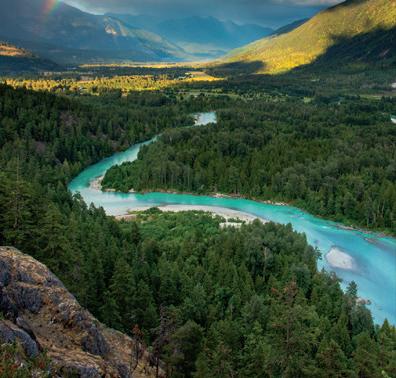



DESPITE APPEALS from some local hiking enthusiasts, the Squamish-Lillooet Regional District (SLRD) will not shift course on its preferred route for the final connection of the Sea to Sky Trail between Whistler and Pemberton.
On Oct. 26, the SLRD board voted unanimously to continue with its original plan to construct the route—from Gord’s Garden (north of Shadow Lake) to Nairn Falls Provincial Park—on the west side of Highway 99.
Detractors had previously pointed out that the proposed route passes Suicide Hill, the Pemberton Speedway, a gun range and active industrial operations, and poses some safety issues at river crossings.

But SLRD staff noted in a report to the board that work to complete the connection has been ongoing since 2012, with the
original route picked several years ago.
The SLRD’s preferred route has nearly completed all stakeholder engagement and permitting processes, with funding secured for trail construction in 2023.
If the district were to change course, and go with a different route being proposed by some hikers, the SLRD would need to go back to the drawing board on consultation, said SLRD project manager Samuel Thompson, in a presentation to the board.


“We’d have to begin new stakeholder engagement and permit applications for Route B; the timeline for that would likely be six to 12 months,” he said.
“With regards to [a proposed bridge crossing], we would require approval of BC Parks, and have to have that surveying and engineering done prior to approval. So we’re saying it would probably be a minimum of 12 months to get all of the approvals in place for the secondary route.”
The estimated cost to complete the remaining eight kilometres of trail between Pemberton and Whistler is $450,000 to $500,000. The SLRD based the estimate on comparable trail projects (while also
factoring in inflation).
The alternate route in question, on the eastside of Highway 99, was floated by a group of hiking enthusiasts called the Citizens for the Sea to Sky Trail earlier this fall.
The route would follow an abandoned logging road along the base of Mount Currie, up a medium-sized hill before dropping down to the edge of Green River. Once at the river’s edge, the trail would hug the cliffside before crossing over a bridge at the popular Nairn Falls, connecting to the rest of the existing trail network.
Proponents argued the route would follow a quieter, less industrial path than the current plan, as it would avoid the Pemberton Speedway, Sea to Sky Soils, the CN Railway and Highway 99.
The proposal would bear a similar cost, but building the new bridge at the waterfall and doing more consultation would add unknown expenses and delays to the trail’s construction.
While the eastside proposal is attractive, it may have come too late in the trailbuilding process, as Route A was identified in the Sea to Sky Trail Master Plan as the
preferred route several years ago.
“The other route looks beautiful, but I think some of those challenges, the bridge in particular, and the cultural considerations mean it will be a very long and expensive process,” said Area B Director Vivian Birch-Jones.
“I think we should proceed with Plan A, and I appreciate the other trail, and they should also proceed, but not necessarily on our dime or with our involvement.”
Area C Director Russell Mack noted the proposed alternate trail could avoid a new bridge altogether by extending to the Green River crossing, which connects the Pemberton Airport road to the base of Mount Currie.
That alternate route could eventually be built as part of the Sea to Sky Trail, in addition to Route A, sometime in the future, SLRD staff noted. However, staff added that this course would require more consultation, and would cross through wetlands and wildlife habitats.
The SLRD estimates construction on the final section of the Sea to Sky trail to Pemberton will begin sometime in 2023. n
STAYING THE COURSE The regional district’sPEMBERTON’S NEW mayor and council took their oaths of office in a short inauguration ceremony on Tuesday, Nov. 1.
After the official swearing-in, the mayor and each councillor had a chance to reflect on the four years ahead.
“We’ve got a lot of work to do,” said Mayor Mike Richman, who marked the beginning of his third term. “We have a mighty little crew and we have a lot of goals and a changing community; we’re facing climate change, we’re facing inflation, all that fun stuff. But with all the change we’re seeing, I think there’s a lot of opportunity for us. I’m really looking forward to managing that change with the four [council members], I’m looking forward to exploring the opportunities that are ahead of us.”
Councillor Ted Craddock said he was looking forward to working with the varied faces at the table as he marked his fifth term.
“Over the years I’ve spent here, I’ve
creating that space of comfort when we’re uncomfortable because there are a lot of issues out there, complicated ones. We’ve got different lenses and the trust that’s required to move through that is really important.”
It is both “a privilege and responsibility” to be sitting at the council table, Coun. Laura Ramsden added.
“I think that anything we do accomplish over the next few years is built on work of those who came before us, so for those of you who were here before—both staff and council—I’m very grateful for the work that you’ve done and I’m really looking forward to getting to know everybody,” she said.
Richman also took a moment to thank departing council members Amica Antonelli, Leah Noble and Ryan Zant.
“As we start this new chapter I do want to acknowledge the outgoing councillors … who put in four hard years with us,” he said. “It was a tough four years, two-and-a-half of which were turned upside down along with the community and the rest of the world and our little organization through the pandemic. It threw our work plan off a little
worked with some really wonderful people and I’m really looking forward to this group of people. I like to see the younger people come on board and I think it’s going to be real change for the community,” he said.
For her part, Coun. Jennie Helmer, a two-term councillor who last served in 2018, highlighted the challenges ahead.
“I look around and I think, ‘What a strong team to land with right now.’ I look ahead, and I see where we’ve come from with so many challenges the last few years and I can’t imagine everything will become easy again—I don’t see it. So, I feel like we’re very fortunate and I am grateful we’re starting from a strong place,” she said.
Highlighting the different backgrounds of everyone at the table, Coun. Katrina Nightingale said the mix will lead to debate, which is essential for council.
“I’m looking forward to getting to know everybody in a more meaningful way and creating that trust,” she added. “That’s so important for healthy debate … and
bit, but I believe our council did some really productive work over the last few years, and I just really want to acknowledge the outgoing councillors for their contribution and commitment.”
Meanwhile, during the meeting, the appointments to various boards and committees were also presented.
The Squamish-Lillooet Regional District board appointments included: Mayor Richman as the Village of Pemberton (VOP) representative to the SquamishLillooet Regional District Board, the Sea to Sky Regional Hospital District Board, Pemberton Lillooet Treaty Advisory, and the Pemberton Valley Utilities and Services (PVUS) committee and Coun. Ramsden as the second member on the PVUS committee.
Other board and committee appointments include: Coun. Nightingale to the Pemberton and District Library board and Cemetery Committee and Coun. Craddock to the Municipal Insurance Association of BC. n




“I believe our council did some really productive work over the last few years, and I just really want to acknowledge the outgoing councillors for their contribution and commitment.”
- MIKE RICHMAN


OTHER THAN A SMALL number of people who’ve bought into fossil fuel industry propaganda or who simply haven’t examined the evidence, everyone knows we’re in a climate crisis. It’s why negotiators from every nation are meeting in Egypt in November for the 27th annual United Nations Climate Change Conference (officially Conferences of the Parties, or COP)—followed by the 15th UN Biodiversity Conference (COP15) in Montreal in December.
From Nov. 7 to 18, representatives of the 197 signatory parties will examine the latest science compiled by the Intergovernmental


 BY DAVID SUZUKI
BY DAVID SUZUKI
Panel on Climate Change and work on agreements to forestall even worse climate consequences than we’re already experiencing—most of which have been predicted since way before countries started meeting in 1995.
From Dec. 7 to 19, representatives will discuss the related biodiversity crisis. Much of the horrific loss of animals and plants over the past few decades has been driven by fossil fuel exploitation and climate disruption, as well as other human activities such as agriculture and development.
So, with 27 years of negotiating, how are we doing? Tragically, not so well.
Atmospheric levels of three major greenhouse gases—methane, carbon dioxide and nitrous oxide—have reached record highs, the World Meteorological
Even though countries agreed at last year’s COP26 in Glasgow to submit strengthened plans, known as “nationally determined contributions,” only 24 had done so as of late October, the Guardian reported, and many of those were not substantially stronger. Delegates have a host of climate-related issues to deal with, from compensating vulnerable nations for “loss and damage” to curbing greenhouse gas emissions, and they need to take it all seriously. Of course, agreements are only as good as the actions they inform.
But halting and reversing the twin biodiversity and climate crises is possible, necessary and more urgent every minute. The 2022 Lancet “Countdown” report describes what the world is already experiencing, from devastating floods in Australia, Brazil, China, western Europe, Malaysia, Pakistan, South Africa and South Sudan to wildfires in Algeria, Canada, Greece, Italy, Spain, Turkey and the U.S., and record temperatures in many countries—with impacts exacerbated by the global COVID-19 pandemic.
The 99 wide-ranging experts who collaborated on the report for the world’s leading medical journal say continued reliance on coal, oil and gas will increase food insecurity, infectious disease and heatrelated illness and death, at staggering costs.
We need to push political representatives to be bolder at the climate and biodiversity conferences. To do so, we must speak louder than the fossil fuel industry, which has used its enormous power, wealth and influence to water down agreements and downplay impacts. At COP26, the industry had 503 delegates—more than any single country!
More evidence surfaces daily about the


Organization reports. As for biodiversity, we recently wrote about the dismal findings of the WWF’s 2022 “Living Planet Report,” which outlines a catastrophic 69 per cent average decline in vertebrate species populations since 1970.
Our understanding of human-caused climate change has increased dramatically since the IPCC’s founding in 1988. That’s sparked a global quest for solutions to the crisis and its impacts, from renewable energy to nature restoration. With so much knowledge and so many existing and emerging solutions, the upcoming conferences are critical.
But the UN says current national commitments to cut emissions wouldn’t prevent the world from heating more than 2.5 C above pre-industrial levels— which would bring about catastrophic climate breakdown. Under the 2016 Paris Agreement, countries pledged to keep global average temperature rise under 2 C, with an aspirational goal of 1.5 C.
industry’s decades-long efforts to downplay, deny and hide evidence—often from its own scientists—that using its products as intended puts human health and survival, and that of all life, at great risk. It’s shortterm gain for long-term pain. Investigative journalist Geoff Dembicki’s The Petroleum Papers offers a chilling exposé of the ongoing campaign by industry and others that’s prevented timely climate solutions and led to the mess we’re in.
We can’t turn away, and we can’t be fooled by the greedy, immoral fossil fuel industry and its media and political supporters. Get informed. Sign petitions. Talk to your political representatives, your friends and family. March in the streets. It’s time to speak up and demand action!
David Suzuki is a scientist, broadcaster, author and co-founder of the David Suzuki Foundation. Written with contributions from David Suzuki Foundation Senior Writer and Editor Ian Hanington.







I WASN’T NECESSARILY thinking of letting this year pass without my annual tirade against contemporary conservatism (the label “modern” would be oxymoronic) or what conservatism in general has become, and yet I hadn’t really planned anything, either. It took the appointment
BY LESLIE ANTHONYof noisome video stuntman Pierre Poilievre (a.k.a. Skippy, or #peepee as he’s known on Twitter) to leader of the Conservative Party of Canada, and the instalment of scarcely credible whacko Danielle Smith as premier of Alberta, to tip my hand. How can I not comment on such a Cirque Désolé?
To begin, these aren’t your run-of-the-mill, greed-mongering, main-street conservatives blindly cheering on de-regulation with no idea of its long-term costs, giddy at the prospect of lower taxes with no clue how government will pay for the health-care, social programs, infrastructure repairs and climatedisaster bailouts they demand, or fervently praying for a de facto petrocracy as blind to the environmental cost of profligate resource extraction as the now-mythical HarperCons with zero awareness how this has already impacted their children’s future. Poilievre and Smith are all that in spades, of course, but go far beyond in sharing—and voicing— decidedly Libertarian and populist views that
SLOW BOIL How did Canada come to its current crossroads? That water has been boiling for some time.
PHOTO BY VICUSCHKAsaw them ascend to their respective positions by actively courting radical fringe elements of national and Alberta conservatism, respectively, which, by dint of Alberta’s farright crown within Canada, turn out to be the same unsettling thing: Luddite freedumb convoys, uninformed anti-vaxx crusaders, zealous religious nutbars, LGBTQophobes, misogynist incels, lobotomized yellowvesters and insurrectionist racists whose ranks include closet white nationalists with “F*ck Trudeau” stickers on their trucks and not a few Confederate and Nazi flags concealed among them. How did Canada come to this crossroads?

Having watched how leading a parade of pariahs concluded in the United States under Donald Trump, that we have politicians having pictures taken with these people should be truly scary to a majority of Canadians. And in case you didn’t notice, it wasn’t hard to draw this cabal—which represents several workable Halloween costumes—from the floorboards and seams of the Big Blue Tent. Following the Trump playbook, Poilievre and Smith literally scanned the landscape for the tribal campfires sporting the most pitchforks and torches, then figuratively invited them over for coffee and doughnuts, no vetting required. No surprise, then, that Poilievre began his own public flirtations by literally bringing coffee and doughnuts to freedumb convoyers during their Ottawa occupation. Now, of course, with the inquiry into the government’s use of the Emergency Act underway, and senior police peeps caught lying in their tracks, Poilievre is mum on the bro-down used to leverage his “let’s make Canada the freest nation on Earth” message (a risible cri de coeur, BTW, given Canada’s perennial top-10 rank in the global Human
and Personal Freedom Indices—ahead of the U.S.). This reeks of the Scheer-andO’Toolian CPC prequels of pandering to far-right islands to secure leadership then immediately dashing for the centre ground occupied by most Canadian voters and going silent on fringe positions around abortion, gun control, and climate change. Smith, an unrepentant RWNJ from the getgo with Alberta’s upstart tea-party-styled Wild Rose provincial nationalists (can’t really call them a party) may, now that she’s in power, have even further to retreat given the depth to which her foot is embedded in her mouth after pronouncing cigarettes healthy, cancer self-controllable, Alberta sovereignty from federal law constitutional (it isn’t and won’t be), the health-care system an enemy, and the unvaccinated “the most discriminated-against people” known in her lifetime. All of which would be embarrassing if it weren’t Alberta— which itself is embarrassing enough.
How did we get here? Well, it seems these characters have more than selfishness going for them, they also have entitlement. In fact, since Harper’s undisguised arrogance (“You won’t recognize Canada when I’m done with it”), Canadian cons have acted as if they deserve to govern on (unsupportable and demonstrably untrue) moral and economic grounds, mewling, after every lost election, about a “popular vote” that doesn’t exist in a multi-party system. Compared to the U.S. where the non-Con/Con divide runs between 50/50 and 55/45, in Canada it’s 65/35 in most elections, often 70/30. The reality is a majority of Canadians do not want a conservative government, and haven’t for some time (the centrist LPC providing all the corporate conservatism
needed). This has served only to make federal conservatives more desperate (remember robocalls?—at least we don’t have legal gerrymandering and vote suppression like the U.S.) and when they do achieve power, they seem bent on using it not as an instrument of construction (which would include the evolution of society and adaptation to changing conditions) but as one of destruction, with a mantra of “tear it all down.” This is more than apparent provincially under Doug Ford and Jason Kenney (and Smith) et al. Today’s conservative playbook is the Trump playbook—enlisting populist Make-Something-Great-Agains to rail against institutions, norms, and democratic conventions by calling into question their veracity (carbon pricing, fake news, fake elections, etc.). In fact, they seem less focused on fashioning a polity of equitable governance than fine-tuning the machine to deceive voters into thinking institutionalized problems—economic, inflationary, interprovincial, domestic and global—are entirely the fault of the governing party when, in fact, these are functionally impossible.
So, like the frog set in water that slowly comes to a boil before the animal can even realize it is dying, here we are. Make no mistake: Poilievre and Smith are terra incognita for Canada, but not without precedent elsewhere. Expect them and their ilk, more hell-bent on rage-farming than ever, to hitch their broken wagons to literally every anti-government conspiracy passing by.
Leslie Anthony is a science/environment writer and author who holds a doctorate in reversing political spin.









 BY STEFAN LABBÉ
BY STEFAN LABBÉ






















All that water is triggering landslides across the region. Vancouver’s North Shore and Chilliwack Valley are hit particularly hard. Water levels rise in the Squamish, Seymour, Chilliwack and Coquihalla rivers. Dikes are under siege.
In the province’s capital, too much rain has broken water mains and flooded basements. Many farms are under water. The Malahat highway is covered in rockfalls and volunteers are stacking sandbags as rivers flood the Cowichan Valley.
On the road, many routes are blocked or diverted so drivers can avoid flooding. Parents are picking up their children at school early, but in downtown cores, it’s business as usual after a break for the holidays.
The minute hand slips to 2 p.m.



“For many, the earthquake is heard before it is felt,” imagines the B.C. government in its latest disaster plan, updated for the first time in seven years as part of its Provincial Earthquake Immediate Response Strategy (PEIRS).
“The low, rumbling sound is similar to that of a freight train, immediately followed by 10-20 seconds of violent shaking that knocks people located closest to the epicentre from their feet—except for those who remember to ‘drop, cover, and hold on.’”




In one scenario, provincial emergency planners modelled what would happen in the event a magnitude 7 earthquake struck the Metro Vancouver region; in another, Greater Victoria is hit with a magnitude 7.3 quake.
In both cases, the destruction is like nothing the region has seen in modern history.
Roads crack as ruptures open up in the ground. Unsecured objects fly through the air.
In low-lying places like Richmond, liquefaction is likely. That’s where the shaking ground forces water up through the soil, sand and stones, instantly turning once solid terrain into a semi-liquid stew. Anything that land once supported gives way, sinking into the morass.
Rockfalls cut off transportation routes. Dikes fail. Fires spring up at the site of ruptured gas and electric lines.
“A small number of buildings collapse, many shift and crack, and others are destroyed by fire,” says the PEIRS report.

On the ground, the government document describes urban landscapes strewn in broken glass and roadways choked in the debris of collapsed buildings.
Some of the worst tragedies are made


magnified by panicked choices.





“Many of those who try to run outside suffer extreme injury or death from falling and flying objects and thousands are trapped or injured,” the report says.



Planning for a collision between climatedriven flooding and a large earthquake leads to some sobering numbers.
If the earthquake were centred in Vancouver, the province projects 2,000 people would be killed, with 1,000 critically injured. Another 6,500 are expected to require hospitalization and 21,000 more would need help from a paramedic or someone who can provide first aid.
Across the province, the combined atmospheric river and earthquake would make over 16,000 buildings uninhabitable and push 70,000 families and individuals from their homes.
An epicentre in Victoria, meanwhile, would lead to 1,000 deaths, 3,700 hospitalizations, and another 10,000 injured. Roughly 43,000 households would be displaced.
In both scenarios, first responders and hospitals would be quickly overwhelmed, and many would likely face deteriorating health as their injuries go untreated.





None of the casualty estimates consider the effects of underlying medical conditions or secondary hazards like “vehicle accidents, falls, explosions, fires, landslides, washouts, tsunamis, or psychological impacts,” notes the report.
Anyone in the backcountry, in the North Shore mountains or beyond, would likely struggle to escape as search-andrescue crews would be overwhelmed or incapacitated.
Structural damage would be everywhere. One million to 1.7 million people would find their homes damaged from the shaking and its aftermath.
Economic activity would screech to a halt. For every day the Vancouver Fraser Port Authority is out of operation, it would lose $647 million in cargo—something that “would have cascading effects across the country.”
Economic losses range from $30 billion if Metro Vancouver were the site of the earthquake’s epicentre, to $20 billion if Victoria were hit hardest.
The report notes that overall economic fallout would likely be much higher, with other studies noting Vancouver alone could face a potential $10 billion in damage.

The initial devastating 20 seconds of shaking wouldn’t end there.
For shallow earthquakes in the magnitude 7 range, strong shaking is expected to cause most of the damage, though landslides, liquefaction, flooding, fires and the outbreak of disease would make things worse.
Aftershocks beyond magnitude 6 “would likely continue for months,” causing further mayhem and psychological damage

It’s 1:59 p.m. on a wet thursday In January. three straIght days of heavy raIn have dropped up to 300 mIllImetres on BrItIsh ColumBIa’s CoastlIne. In the alpIne, temperatures are ClImBIng, sendIng meltwater downrIver.
to already traumatized residents.




“There is a small chance that an ‘aftershock’ could be larger than the initial event,” write the authors of the government report.


In the meantime, small businesses would be severely impacted by supply-chain disruptions, and bank services—including ATMs—could be left largely unavailable, the report notes.
Basic services like water, electricity and gas would likely be cut or disrupted “for many months.”
With cell networks overloaded, text messaging would probably be one of the easiest ways to communicate. Even radio communication could face congestion as non-sanctioned operators and emergency services compete for airwaves.
“There may be increased reliance on backup communication methods, such as satellite phones and amateur radio services,” notes the report.
In the city, congested shelters and a lack of waste disposal could lead to outbreaks of disease. On the other hand, isolated communities with one road or bridge in and out of town could be entirely cut off for long periods of time.
After a catastrophic earthquake, the B.C. government is expected to shift all its priorities to disaster response, notes the document.
The Office of the Premier and cabinet would direct the Provincial Emergency Coordination Centre in Victoria, which in turn, would pass information to regional and local emergency coordination centres, municipalities and First Nations.
In the worst-case scenario, the province may set up a Catastrophic Emergency Response and Recovery Centre to provide unified command and share information with the press and public.
Emergency Management BC (EMBC) would activate the province’s earthquake response strategy, recommend government declare a state of provincial emergency, and contact Public Safety Canada for federal assistance.
The federal government would almost certainly activate CONPLAN PANORAMA,





The scenario does not consider the use of an earthquake early-warning system—one that is already partially deployed and expected to become operational across parts of B.C. in the coming years.
Once up and running, that system could give people a warning “on the order of minutes,” allowing many to escape collapsing buildings and buckling tunnels and bridges.
With warning, SkyTrains could be halted, surgeons would have a chance to stabilize patients, and firefighters would open fire hall doors, giving them a head-start.
At the same time, the provincial report notes, the modelled scenario makes a lot of assumptions.
In the event of a real earthquake, “it may take hours or even days to collect situational awareness equivalent to what is presented here.”



The report and its hypothetical scenarios came the same week millions of B.C. residents had the chance to practice their own reaction to an earthquake (the annual Great British Columbia Shake Out encourages people to practice how to drop, cover and hold).

And this February, municipal governments across B.C. will join their B.C. and federal counterparts to hold a large-scale earthquake dry-run dubbed Exercise Coastal Response 2023. Working with First Nations, it’s meant to “validate elements of the new strategy and reinforce the importance of crossjurisdictional partnerships in emergency situations,” according to a recent press release from the province.
As part of its plan to seismically upgrade infrastructure like bridges and highways, the Ministry of Transportation has earmarked $5 million a year.
a contingency plan for the Canadian Armed Forces in the event of a catastrophic earthquake on the coast of B.C. That would mean deploying soldiers to staging areas across Vancouver Island, the Lower Mainland or the Southern Interior.
The military would be tasked with





supporting communities directly hit by the earthquake or cut off from its effects. In the same way military units were flown into parts of B.C. during last year’s floods, the armed forces may also be deployed to Indigenous communities, but only after consultation with their leadership.
School seismic retrofits, on the other hand, still have a long way to go, despite $2 billion in approved and promised funding.
As of Sept. 22, 204 B.C. schools had been seismically upgraded, while 22 were under construction. Another 268 schools across the province have yet to receive retrofits and remain vulnerable to a catastrophic earthquake. ■






































































AS THE COVID-19 pandemic landed in B.C. in earnest on the eve of bike season in early 2020, Katrina Strand seems to have been uniquely suited to adapt.
The former pro mountain biker, who operates mountain bike coaching and performance training under the Strand Training umbrella, had recently had her first child and was plotting her re-entry into the industry when the pandemic hit.
“Everything was at a standstill and, to be honest, I wasn’t totally sure how I was going to rebuild in the first place,” she said. “We were all in the unknown, not just people in my industry.”
With gyms shut, performance training was off the table in the first several months. Strand was keeping herself in shape in preparation for re-opening, but then broke her femur in July of 2020, which sidelined her for six weeks and allowed her to fully focus on how she was going to come back.
“Having that extra time and having to sit on my couch gave me the space and the time to really dot all the i’s and cross all the t’s,” she said, noting she completed tasks such as finishing her tenure application and fine tuning the online booking system on her website. “I certainly felt a lot more organized. I’m an organized person to begin with, but I really felt like I had all my ducks in a row coming into 2021.”
That preparation allowed Strand to reap the rewards of training those who embraced
mountain biking as a safe activity in 2020, as the business rebounded well in 2021 even without a significant boost from tourism.

“It picked up quickly because a lot of people dove into mountain biking during the pandemic as something to do,” she said, noting that business didn’t increase significantly this summer with an increased tourism market.
virtually from all over North America and as far away as Europe.
As well, the livestream classes respect that individuals discovered new ways to stay fit at home.
“A lot of habits have changed. A lot of people’s training rituals have changed,” Tomlinson said. “We have a lot of people who ride with us who like their home gym, or they invested a lot in that.
While outdoor programs weren’t significantly restricted by health orders in the sense that they could operate, operations reliant on tourism had to adapt or risk wilting.
PHOTO BY TRISH BROMLEYStrand wasn’t the only outfit to endure a pandemic-related shift.
TaG Cycling co-founder Lesley Tomlinson, a two-time Olympian in road
“Or they found us online and they’re somewhere back east or they’re somewhere down south and they like training with us. We’re still supplying that (livestream service) so we can reach those people.”
Tomlinson expressed some frustration,
Paul Howard, owner of ZEP Mountain Bike Camps, said his first COVID-related thoughts were to do with the health and safety aspect of the global health crisis, but when considering the business, the uncertainty was unsettling.
“You think about the summer ahead, what are we going to do?” he recalled. “The obvious question is (about) what can stay and what’s going to disappear. At the time, a lot of our coaching products were a little bit more focused on destination riders.”
When it became clear that the Whistler Mountain Bike Park would not open and borders would remain locked down, ZEP shifted from weekend and week-long camps for travellers to heavily emphasizing its offerings for locals.
cycling and mountain biking, noted that the company was approaching its 10-year anniversary when COVID hit.
Closing its doors before the provincial order came down, TaG pivoted to filming complimentary online videos and quickly established how to livestream classes, which became a key element to the business as its indoor studios closed for 20 of 24 months following COVID’s arrival.
Tomlinson said many clients discovered TaG through YouTube, with a significant portion of them having no connection to the area. Many attended
however, with how shutdowns were conducted in subsequent waves of the pandemic. TaG’s studios were open in a physically distant manner heading into the 2020-21 winter season, but in December 2020, facilities deemed to offer highintensity training were forced to close while other fitness centres could remain open.
“We’d have people doing our workouts in their gym, whatever gym it was they were allowed to go to, that had different rules than us,” she said. “It was a confusing directive in a lot of ways.”
“We’ve always been able, because of our coaches and our backgrounds, to offer a variety of programs. We’ve had stuff for kids, for adults, for expert riders,” he said. “The locals’ programs and kids’ programs, we already had going. We just shined a light onto those programs and built those programs up more.”
Increasing service to the local market had been on ZEP’s radar for some time, and the COVID disruption made that desire a necessity, according to Howard.
“It was great because it was something we had always wanted to do,” he said. “The response was awesome because as programs filled up, and with the bike park closing, the opportunity was there as well for people to look out for our programming.”
Even with the destination market
“A lot of habits have changed. A lot of people’s training rituals have changed.”
- LESLEY TOMLINSON
returning to town, the focus on local programming has remained, with visiting riders offered private training or the opportunity to integrate into an existing program.

Though Howard’s company pulled its focus inward, he retained a broad focus personally. As technical director with the Professional Mountain Bike Instructors Association (PMBIA), he helped draft policy used by outfits in Canada, the United States and Australia, seeing those actions as important to contribute and protect the industry.

“The ski industry essentially just shut down, so we couldn’t even look to them to think, ‘Well, how did they do it?’” he recalled. “If we all get through this stronger, then the whole industry is going to be better.”

Howard noted that operators in places such as Australia faced more restrictive policies and could not run courses despite being outdoors, which created issues for creating broad policies.
“COVID was more challenging for PMBIA because not only were the COVID policies different in different locations, ultimately meaning there were a lot of places we couldn’t operate, but the policies kept changing, so it just seemed like endless scheduling, rescheduling and postponing of courses,” Howard wrote in a followup email. “The PMBIA office staff did an incredible job trying to keep on top of it all and without that hard work, PMBIA wouldn’t have been able to offer the amount of courses it did during COVID.”
The travel restrictions also set the PMBIA back in holding course conductor classes, though a new online training portal is helping to address the backlog.
Though there has been a general sense of a return to normalcy, Tomlinson said that things still haven’t settled entirely. Still, with co-founders and fellow Olympians Chrissy de Vall and Gina Grain on board, there’s a shared mindset of pushing forward.
“It’s still unknown where we’re all going to end up,” she said. “A lot of us come from a high level in cycling and a few of us come from a high level in other sports, and we’re trained to persevere and to deal.”
For its part, TaG has changed its Whistler operations, moving in with Treeline Aerial in Function Junction.

“It’s cool to be with people doing very different things but with the same kind of business motif and ability to make it work,” she said.
Strand, meanwhile, is still feeling repercussions of the effects on the strength and conditioning side, especially staring in the face of a recession. With services like athletic training generally not covered by insurance, they’re often a casualty of tightened budgets.
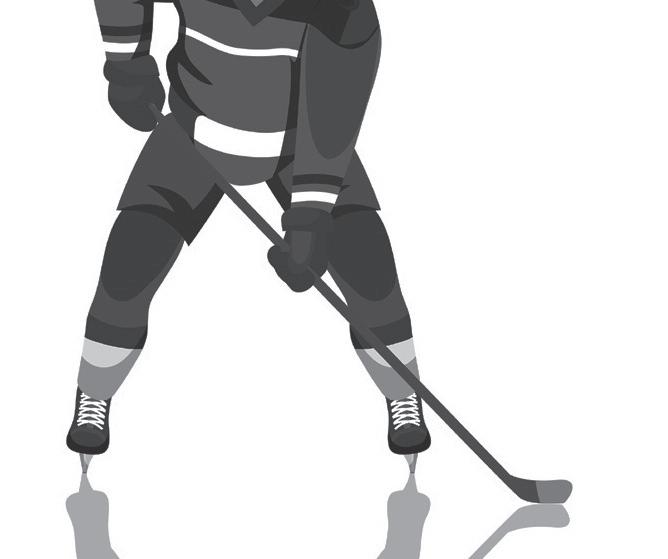

“People are becoming more and more careful with their income and what they choose to spend money (on),” she said.
While ZEP has shifted into its COVIDnecessitated adaptations, Howard has been in the industry long enough to know that there will be another disruption in the years to come that requires an adaptation that will make the business stronger on the other side. The hope is that it comes in the form of something far less grim, such as the need for a new website or progression within the industry.
“There’ll be another challenge in three or four years and either you adapt and keep going or you let it slow you down,” he said. n
MONIRA AL QADIRI is a Kuwaiti artist sometimes referred to as a “prophet of doom with an ear for a joke.”
Her current exhibition at Texas’ Blaffer Art Museum is called “Refined Vision,” an ironic reference to all the fossil fuels at the heart of her show and our carbonbased economy. That includes Monira’s birthplace, Kuwait, which depends on hydrocarbons for about half of its GDP. (For Canada, that number is about five per cent of our GDP.)
BY GLENDA BARTOSHMore irony: the centrepiece of her exhibition is “Crude Eye,” a video commissioned with funding from a centre set up by the wife of the late George P. Mitchell, a billionaire and hydraulic fracturing engineer who made his fortune from—you guessed it—fracking.
Not to be a prophet of doom, but it turns out the joke’s still on us as world leaders meet Nov. 6 to 18 for COP 27 in Sharm el-Sheikh, a beautiful resort town that depends on monied visitors. Hey, like Whistler! Only it’s in Egypt, a quarter of whose GDP is based on oil and gas. And, no, Greta will not be going. She calls the whole thing “greenwashing.”
Wow.
Beyond the crazy heat and drought, and the atmospheric river we just experienced— all of which has been disastrous for our farmers and overall food and water supplies—I shouldn’t need to remind you where we’re at in terms of climate on the eve of COP. But I will.
To start, COP is the conference where the IPCC (the UN-based Intergovernmental Panel on Climate Change) presents its findings regarding the latest science on climate change. The IPCC’s April report—called the final warning to governments about climate breakdown—says that the only hope for the world to avoid the worst disasters of climate change is a “now or never” race to a lowcarbon economy and society.
The World Meteorological Organization reports that heat-trapping greenhouse gases reached record highs in 2021 and continue to rise “…showing that we’re heading in the wrong direction.” Of the 193 countries that agreed last year to crank up their climate action, only 23 have done so!
Even COP 27’s chair, Sameh Shoukry, Egypt’s foreign minister, says the goal of limiting warming to 1.5 C is “more fragile” than ever, due to geopolitical tensions worldwide, like the war in Ukraine.
Meanwhile, irony mocks again as Svalbard, Norway, home to the giant underground global vault storing seeds as back-up for world crop diversity, is the fastest warming place on Earth!
As new councils get underway, and people are hugely disappointed, if not downright freaked, that most jurisdictions, including Whistler, aren’t meeting their climate targets, I asked some key locals for their take on the Resort Municipality of Whistler’s commitment to its climate plan
to reduce greenhouse gas emissions by 50 per cent by 2030—and how things might shake out.
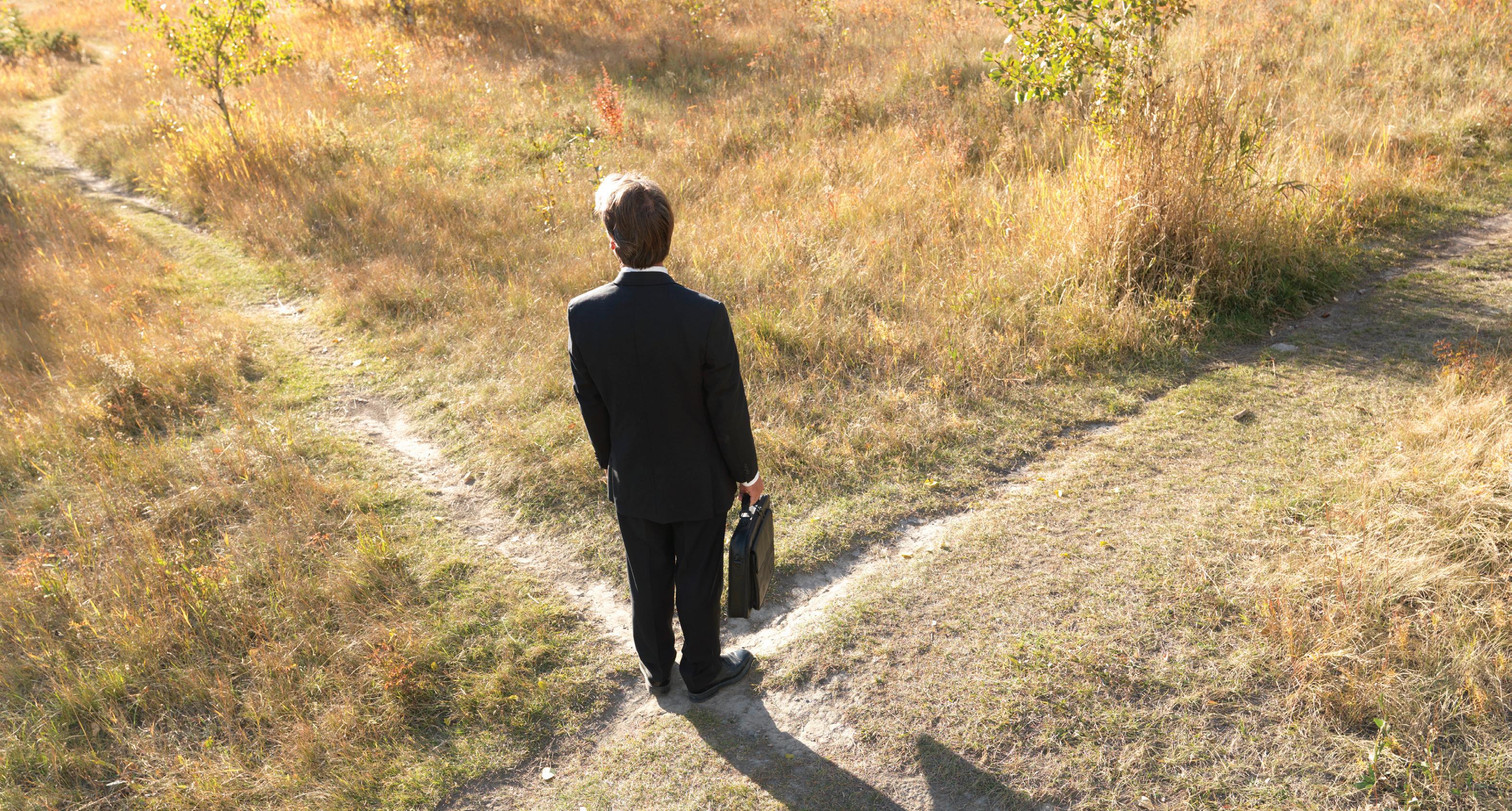
While no one can, or should, comment on an incoming council at such early stages, some interesting points came out.
Cheeying Ho, the Whistler Centre for Sustainability’s E.D., had some great advice about where the new council should focus: really invest in active transportation and capitalize on the e-bike revolution. Continue to push aggressively for regional transit, including to Mount Currie. And identify ways to allow infill rental housing, which uses existing land and infrastructure more efficiently and is better for the climate, in all neighbourhoods.
For decades, forest ecologist and Whistler Naturalists founder, Bob Brett, has been reminding councils—and all Whistlerites— about the importance of protecting the environment, and biodiversity. While he doesn’t profess to know what, at a municipal level, can be done to address climate change, he does know that “you can’t get out of climate change by replacing a municipal fleet with EVs.”
In his view, most of the best ways to reduce or mitigate climate change are landbased: protect old forests, and manage second-growth in a way that restores more old forest habitat, like by not logging them again, or by doing selective logging.
Like lots of locals, Bob also feels that the municipality has been way too slow when it comes to meeting its own climate goals.
All of this is not lost on Arthur De Jong, who has just been re-elected to his second term on council. He’s been known as Mr. Environmental, especially for all the good work he did on Whistler
Blackcomb’s enviro file before he retired, like setting up a zero-footprint plan that spread to all Vail mountain resorts and did things like reduce waste by 70-plus per cent.
“Through my first four years … I very much felt a keen, driven RMOW staff on climate,” says Arthur. “In fact, I always felt encouraged, and I know when I would get worked up [that] we are not moving at the rate we need to be moving on on this, staff would smile.
“They want to push harder, and the same with Jack. But, clearly,” he adds, “we’re not meeting our goals in terms of carbon reduction. We know we need to find the means and the ways of accelerating.”
With that acknowledgement, and the fact that no one knows exactly what Whistler’s new council will do, Arthur is still confident they’re all pretty much in the same boat—a green one.
I’ll go one step further and say if you’re a political nerd like me, and track council (see my letter to the editor this week along those lines), place your bets that finally some big, tangible initiatives will be coming down the line for Whistler.
While we fidget, waiting for those, remember that as the leaders we elected meet at COP 27, or around council tables, to tackle the climate disaster, you and I need to step up our own behaviour and not leave it to them, or the artists. We need to radically cut greenhouse gas emissions in our own lives like never before.
You know how—so do it.
Glenda Bartosh is an award-winning journalist who is plenty scared, especially for the young ones growing up. n


I Mountain
R Swim Fit 7:45-8:30 a.m. Marie-Anne
I Aqua Fit Shallow 8:45 9:45 a.m. Marie-Anne

I Low Impact Strength 9 10 a.m. Anna
R Prenatal Fitness 5:30-6:30 p.m. Sara

F Spin 6-7 p.m. Courtney
F Dryland Training 6:45-7:45 p.m. Garret
I Yoga Roll & Release 8-9 p.m. Laura
I Full Body HIIT 9-10 a.m. Alex
I Gentle Fit 1-2 p.m. Garret
I Low Impact Strength 9 10 a.m. Marie-Anne
I Zumba 10:30-11:30 a.m. Carmen
I Yin & Yang Yoga 9 10 a.m. Heidi
F Barre Fit 12:15-1 p.m. Marie-Anne





I Strength

Lou

R Swim Fit 7:45-8:30 a.m. Marie-Anne
I Strength & Stretch 7:30-8:30 a.m. Lou
I TRX Mixer 5:15-6 p.m. Courtney
F Spin 6:15-7:15 p.m. Courtney
I Strong Core & Glutes 6:15-7:15 p.m. Carly
I Aqua Fit Deep 8:45 9:45 a.m. Marie-Anne

I Strength & Stretch 9 10 a.m. Lou
I Zumba 12:15-1:15 p.m. Carmen

I Mountain Ready Conditioning 5:30–6:30 p.m. Anna
F Spin 6-7 p.m. Courtney

F Dryland Training 6:45-7:45 p.m. Garret

I Slow Flow Yoga 8 9 p.m. Laura
I Strength & Cardio 9 10 a.m. Lou




F Mom & Baby 2.0 10:30-11:30 a.m. Sara
I Gentle Fit 1-2 p.m. Diana
I HIIT Express 5:15-6 p.m. Alex

F Spin 6:15-7:15 p.m. Alex
I Zumba 6:30-7:30 p.m. Carmen
Learn more at whistler.ca/swim | 604-935-PLAY (7529)




Visit whistler.ca/notices for Meadow Park Sports Centre operational changes and closures. whistler.ca/notices | 604-935-PLAY (7529)






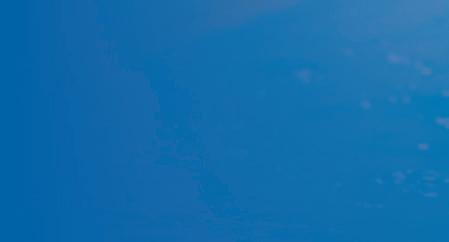




DO YOU KNOW who is most likely to get lost and call search and rescue (SAR) for help this time of year?
Cathalynn Labonté-Smith does.
“Mushroom pickers,” she says. “I started reading about how mushroom pickers get lost: they have their heads down, they’re secretive, they don’t want anyone to know where they are [to keep their picking locations secret].”
That might be how a mother and her 20-month-old got lost while on the hunt for fungi in Powell River. After an overnight search, a SAR team located them and ushered them to safety via ATV.
“It did have a happy ending,” she adds. “Any time there’s a child involved in a rescue, everybody comes out.”
Labonté-Smith, who splits her time between North Vancouver and Gibsons, where her husband is a search-and-rescue volunteer, knows not only about mushroom pickers, but also avalanche, cave, K9, ice, and swift-water rescues, too.
That’s because she spent months interviewing SAR volunteers from across North America for her new book, Rescue Me: Behind the Scenes of Search and Rescue, which came out in early October.
“We’ve all seen the North Shore Rescue series [Search and Rescue: North Shore] on the Knowledge Network. I was like, ‘OK, why isn’t there also a book?’ My husband
that have stayed with you?”
“All of them had a couple of cases that came to mind,” she says. “To me, it’s like, I’m not there to sensationalize anything. I’m here to relay the story as accurately as I can. I sent them all drafts so they could go through and make sure it was accurate and the tone was accurate.”
The rescuers didn’t disclose anyone’s
had a rare condition that caused him to go into shock when he got cold, unbeknownst to his friend—studying to become mountain guides out in winter conditions.
The man with the condition became injured, and suddenly was paralyzed. Luckily, his partner had enough knowledge to build a snow cave, rest him off the snow on skis, and have GPS coordinates handy for SAR.
“It took this huge team to get him out,” Labonté-Smith says. “It took 25 belays to lower him and navigate him out.”
Her hope is that readers will glean lessons from these stories—and understand the work, money, and hours that go into volunteering as a SAR member.

is in the Sunshine Coast search and rescue, and he was going through his training, which no one was talking about. The pandemic hit and I had questions in mind: how does B.C. search and rescue compare to the rest of North America?” she says.
That became the impetus for the book.
Labonté-Smith started out by emailing every SAR organization in Canada and the U.S. Her main question: “What are the cases
identity, but Labonté-Smith managed to track down some people who had been rescued—or their family members—to learn more about their side of the events.
“The majority were thrilled,” she says. “They were so happy people weren’t going to forget their loved ones.”
Whistler, Pemberton, and Squamish SARs are also featured in the book. One story from Whistler was about two men—one of whom
“The book isn’t to discourage people from going out there and adventuring,” she says. “It’s to focus on what the volunteers of search and rescue do—the fact that they are volunteers. Go out there, be prepared, have a plan, preferably take someone with you and have a great time and be reasonable about what you’re doing, so they don’t have to tell your loved ones you didn’t make it back.”
Labonté-Smith will be in Whistler for a reading at the Whistler Public Library on Nov. 8 at 7 p.m., along with Yvonne Thornton and her dog Dyna, who is part of the Canadian Avalanche Rescue Dog Association.
The event is free, but registration is required by emailing publicservices@ whistlerlibrary.ca. n
NEW HEIGHTS Author Cathalynn Labonté-Smith has released a new book called Rescue Me: Behind the Scenes of Search and Rescue.“I’m not there to sensationalize anything. I’m here to relay the story as accurately as I can.”
- CATHALYNN LABONT É-SMITH
TO HEAR HIS WIFE describe it, in the first weeks of the pandemic, Scott Meek had lost his sparkle.
“The first week when everything shut down Scott was looking gloomy every day,” Clare Yuan recalls. “I said, ‘What’s wrong with you?’ And he said, ‘We don’t get to play anymore.’”
But it wasn’t long before they figured out the benefit of being in a four-hands piano duo with your partner: the Meeks Duo could still perform online from home.
They ordered all the tech they needed for high-quality live-streaming and started staging their performances on the internet.
Shortly after, they received a National Arts Centre grant and began streaming through the centre’s platform as well.


“After that, Scott’s eyes became sparkly again,” Yuan says. “We decided to do it every week.”
Their run lasted for 22 weeks, but it turned out to have a big impact on their music.
“We did a new program every week for 22 weeks. We learned so much repertoire during that time,” Yuan adds.
For Meek, the contradictory mix of more time and more performances led to new creativity. He began to experiment with piano “mash ups.” (Perhaps not the official term in classical music.)
“When we played Whistler [in 2018], I didn’t have any of my own arrangements,” he says. “I think I did my first in 2019, but since 2020, I’ve got nearly 100 of my own arrangements.”
As the duo has returned to in-person performances, that has meant audiences now get completely unique shows where, for example, Beethoven’s “Symphony No. 5” is mixed seamlessly with “Happy Birthday,” or “Fly Me to the Moon” is woven
into “Moonlight Sonata.” (You can see it for yourself at: youtube.com/c/TheMeeksDuo.)
Their return to Whistler on Sunday, Nov. 6, will offer a program filled with those unique arrangements.
“It’s nice for the audience because they’re getting an experience they won’t get anywhere else,” Meek says. “We’re the only ones doing it.”
In that way, the pandemic offered a few blessings in disguise.
“It made us grow in so many ways,” he adds.
It also didn’t hurt that the pair was able to capitalize on a big opportunity in 2019, just before the pandemic, when they decided to fly to Taiwan, where Yuan is originally from, and Japan, where Meek still has family, to visit loved ones and perform a pair of shows.
They played polar opposite venues: The National Concert Hall in Taiwan and a cafe in Japan.
“The Japanese have a reputation of being very shy, but by the end some people were laughing and someone yelled out, ‘Encore!’” Yuan says.
But, for the most part, “pianists don’t face the audience when they perform,” Meek points out. “We face the side, so while we’re playing it doesn’t make much difference [where we are].”
That might be true, but they’re still looking forward to their return to Whistler.
“We recorded the concert on video [last time]. In the middle of the concert you could see the snow falling outside the windows. It was really cool,” Yuan says.
Catch The Meeks Duo at the Maury Young Arts Centre on Nov. 6 from 5 to 6:15 p.m. as part of the Whistler Chamber Music Series. Tickets are $25 for adults or $20 for youth under 20.

Get them at showpass.com/meeks-duo.
For more on the duo, visit themeeksduo.com.
Join Arts Whistler every week in November for a series of fun Indigenous-led workshops at the Maury Young Arts Centre. Don’t miss this weekly opportunity to build stronger relationships, share in Indigenous knowledge, and foster greater understanding.


> Events scheduled for Nov. 3, 10, 17 and 25. Prices, venues and start times vary.


> Head to artswhistler.com/emham for tickets and more info.



Married Vancouver-based pianists Scott Meek and Clare Yuan are The Meeks Duo, an acclaimed four-hands piano duo whose aim is to make every performance a uniquely enjoyable experience. They are recognized for their groundbreaking inventiveness and uniquely diverse repertoire for piano duet. Presented by the Whistler Chamber Music Society.
> Maury Young Arts Centre
> Sunday, Nov. 6 at 5 p.m.
> $25/adult; $20/youth, available in advance online at whistlerchambermusic.ca and at the Maury Young Arts Centre.
K-Man & The 45s—where ska meets rock ‘n’ roll. This Canadian five-piece band from downtown Montreal is as heavily influenced by old-school ska as it is by classic rock ‘n’ roll. With a fantastic horn section playing catchy melodic lines and blazing solos over an energetic rhythm section, they switch naturally from ska to rock and punk, with surf sounds often not far behind.
> Sun., Nov. 6 at 7 p.m.
A brand-new market hosted by your local artists featuring creatives from the Sea to Sky and across B.C. This two-day event will feature up to 40 vendors in Whistler’s biggest indoor market since 2019.
> Fairmont Chateau Whistler, Frontenac Foyer and Ballroom

> Nov. 26, 11 a.m. to 6 p.m. Nov. 27, 11 a.m. to 5 p.m.
> Entry by can or coin donation to Whistler Community Services Society























































































SNOW TIRE SEASON is upon us! Even through snowy and icy conditions, you will see all types of vehicles tackling the Sea to Sky Highway today. Fifty years ago, however, one car dominated the snow, and that was the Volkswagen Beetle.

In the 1960s, Volkswagen touted the VW Beetle as the best car for driving in the snow, and North America listened. In one famous commercial, a Beetle is seen driving through snowy conditions. The narrator asks, “Have you ever wondered how the man who drives the snowplow, drives to the snowplow? This one drives a Volkswagen, so you can stop wondering.”

At this time, most American-made cars were rear-wheel drive and had their heavy engines at the front, resulting in little weight over the drive wheels and thus less traction. Despite also being rear-wheel drive, the Beetle did better in the snow because the engine was also in the rear, giving the drive wheels more traction for slippery conditions. Somewhat surprisingly, the narrow wheels also seemed to help, because the Beetle cut through the snow rather than riding on top.
In 1965, Cliff Jennings bought his 1957 Beetle before heading out west to Alta Lake. It was not a straightforward journey. “When I arrived in Vancouver, nobody had heard about this new area, so I just headed blindly north,” Jennings recalled.







“Two hours later, in Squamish, I got directions and headed up a steep gravel road, arriving eventually at a dead end with a trailhead sign posted to Diamond Head. Back in Brackendale, I hung a right and headed blindly north again on what would now be called a four-by-four road. The first sign of civilization was Garibaldi and Daisy Lake Dam, which the road proceeded over onto a detour around Shadow Lake through huge puddles that nearly drowned
my Beetle. Finally, five hours after leaving Vancouver, I arrived at a big slash clearing and a swampy parking lot in pouring rain.” Cliff had made it to the ski resort!
Jim Moodie arrived in Whistler a few months later, once the lifts had opened, also driving up in his Volkswagen Beetle. “People remark about the road being bad nowadays, but the road then, a lot of it was gravel, and so it was a frightening experience if we were smart enough to think about it, but we mostly didn’t,” he said. “I can remember one day driving up and the car simply stopped moving forward. At least that’s what we thought had happened. When we got out to see what was happening, the Volkswagen Beetle was just plowing up a great big snowdrift in front of it so we couldn’t go anymore.” Good in the snow, but not quite a snowplow.
The imagery of the Volkswagen Beetle was so connected to mountain towns that Whistler Mountain’s 20th anniversary poster featured a red Volkswagen Beetle driving off into the sunset. In the iconic Whistler poster, the car is covered in stickers with skis jammed into the bumper.
With many people sharing similar memories, it is no wonder the photographs of Volkswagen Beetles in the snow are popular prints at the Whistler Museum. You can see some of the Whistler Museum image collection here: whistlermuseum. smugmug.com.
“I can remember one day driving up and the car simply stopped moving forward.”
- JIM MOODIE













ARIES (March 21-April 19): In the coming weeks, I encourage you to work as hard as you have ever worked. Work smart, too. Work with flair and aplomb and relish. You now have a surprisingly fertile opportunity to reinvent how you do your work and how you feel about your work. To take maximum advantage of this potential breakthrough, you should inspire yourself to give more of your heart and soul to your work than you have previously imagined possible. (PS: By “work,” I mean your job and any crucial activity that is both challenging and rewarding.)

TAURUS (April 20-May 20): Here’s my weird suggestion, Taurus. Just for now, only for a week or two, experiment with dreaming about what you want but can’t have. And just for now, only for a week or two, go in pursuit of what you want but can’t have. I predict that these exercises in quixotic futility will generate an unexpected benefit. They will motivate you to dream true and strong and deep about what you do want and can have. They will intensify and focus you to pursue what you do want and can have.
GEMINI (May 21-June 20): Your most successful times in life usually come when all your various selves are involved. During these interludes, none of them is neglected or shunted to the outskirts. In my astrological opinion, you will be wise to ensure this scenario is in full play during the coming weeks. In fact, I recommend you throw a big Unity Party and invite all your various sub-personalities to come as they are. Have outrageous fun acting out the festivities. Set out a placemat and nametag on a table for each participant. Move around from seat to seat and speak from the heart on behalf of each one. Later, discuss a project you could all participate in creating.
CANCER (June 21-July 22): A Cancerian reader named Joost Joring explained to me how he cultivates the art of being the best Cancerian he can be. He said, “I shape my psyche into a fortress, and I make people feel privileged when they are allowed inside. If I must sometimes instruct my allies to stay outside for a while, to camp out by the drawbridge as I work out my problems, I make sure they know they can still love me—and that I still love them.” I appreciate Joost’s perspective. As a Cancerian myself, I can attest to its value. But I will also note that in the coming weeks, you will reap some nice benefits from having less of a fortress mentality. In my astrological opinion, it’s PARTY TIME!
LEO (July 23-Aug. 22): Leo poet Antonio Machado wrote, “I thought my fire was out, and I stirred the ashes. I burnt my fingers.” I’m telling you this so you won’t make the same mistake, Leo. Your energy may be a bit less radiant and fervent than usual right now, but that’s only because you’re in a recharging phase. Your deep reserves of fertility and power are regenerating. That’s a good thing! Don’t make the error of thinking it’s a sign of reduced vitality. Don’t overreact with a flurry of worry.
VIRGO (Aug. 23-Sept. 22): Virgo author Siegfried Sassoon became renowned for the poetry he wrote about being a soldier in the First World War. Having witnessed carnage first-hand, he became adept at focusing on what was truly important. “As long as I can go on living a rich inner life,” he wrote, “I have no cause for complaint, and I welcome anything which helps me to simplify my life, which seems to be more and more a process of eliminating inessentials!” I suggest we make Sassoon your inspirational role model for the next three weeks. What inessentials can you eliminate? What could you do to enhance your appreciation for all the everyday miracles that life offers you?
LIBRA (Sept. 23-Oct. 22): You Libras have a talent that I consider a superpower: You can remove yourself from the heart of the chaos and deliver astute insights about how to tame the chaos. I like that about you. I have personally benefited from it on numerous occasions. But
3 BY ROB BREZSNYfor the next few weeks, I will ask you to try something different. I’ll encourage you to put an emphasis on practical action, however imperfect it might be, more than on in-depth analysis. This moment in the history of your universe requires a commitment to getting things done, even if they’re untidy and incomplete. Here’s your motto: “I improvise compromises in the midst of the interesting mess.”

SCORPIO (Oct. 23-Nov. 21): “Fear is the raw material from which courage is manufactured,” said author Martha Beck. “Without it, we wouldn’t even know what it means to be brave.” I love that quote—and I especially love it as a guiding meditation for you Scorpios right now. We usually think of fear as an unambiguously bad thing, a drain of our precious life force. But I suspect that for you, it will turn out to be useful in the coming days. You’re going to find a way to transmute fear into boldness, bravery, and even badassery.
SAGITTARIUS (Nov. 22-Dec. 21): For decades, the Canadian city of Sudbury hosted a robust mining industry. Deposits of nickel sulphide ore spawned a booming business. But these riches also brought terrible pollution. Sudbury’s native vegetation was devastated. The land was stained with foul air produced by the smelting process. An effort to re-green the area began in the 1970s. Today, the air is among the cleanest in the province of Ontario. In the spirit of this transformation, I invite you to embark on a personal reclamation project. Now is a favourable time to detoxify and purify any parts of your life that have been spoiled or sullied.
CAPRICORN (Dec. 22-Jan. 19): The literal meaning of the ancient Greek word aigílips is “devoid of goats.” It refers to a place on the Earth that is so high and steep that not even sure-footed goats can climb it. There aren’t many of those places. Similarly, there are very few metaphorical peaks that a determined Capricorn can’t reach. One of your specialties is the power to master seemingly improbable and impassable heights. But here’s an unexpected twist in your destiny: In the coming months, your forte will be a talent for going very far down and in. Your agility at ascending, for a change, will be useful in descending—for exploring the depths. Now is a good time to get started!
AQUARIUS (Jan. 20-Feb. 18): Evolved Aquarians are often blessed with unprecedented friendships and freespirited intimacy and innovative alliances. People who align themselves with you may enjoy experimental collaborations they never imagined before engaging with you. They might be surprised at the creative potentials unleashed in them because of their synergy with you. In the coming weeks and months, you will have even more power than usual to generate such liaisons and connections. You might want to make a copy of this horoscope and use it as your calling card or business card.
PISCES (Feb. 19-March 20): I surveyed the history of literature to identify authors I consider highly intuitive. Piscean-born Anais Nin was my top choice. She used language with fluidity and lyricism. She lived a colourful, unpredictable life. No one better deserves the title of Intuition Champion. And yet she also had a discerning view of this faculty. She wrote, “I began to understand that there were times when I must question my intuition and separate it from my anxieties or fears. I must think, observe, question, seek facts and not trust blindly to my intuition.” I admire her caution. And I suspect it was one reason her intuition was so potent. Your assignment, Pisces, is to apply her approach to your relationship with your intuition. The coming months will be a time when you can supercharge this key aspect of your intelligence and make it work for you better than it ever has before.
Homework: Imagine you have taken a particular consciousness-altering drug. Imagine how it affects you.
In addition to this column, Rob Brezsny creates EXPANDED AUDIO HOROSCOPES
In-depth weekly forecasts designed to inspire and uplift you. To buy access, phone 1-888-499-4425. Once you’ve chosen the Block of Time you like, call 1-888-682-8777 to hear Rob’s forecasts. www.freewillastrology.com
Lot For Sale:



Lake Subdivision

ACRE • $650,000
5.44 ACRE Lot 51, Ivey Lake Subdivision, $650,000, 2-minute walk to Lake. 2.3 Km northeast of Pemberton, a 30-minute drive to Whistler. Fantastic view of Mt Currie. 604-744-8816 owen.hairsine@gmail.com

FAIRMONT CHATEAU WHISTLER is growing its Housing portfolio and sourcing additional seasonal and longterm Chalet and Condo contracts for our Hotel Management Team Members.

Our leaders are mature, career driven drivers that know the word respect. Contract terms for property Owners are stress free with no commissions and includes representation from our 4 person fulltime Housing Department working with you 24/7; maintaining all aspects of the tenancy including quarterly inspections.
A great next move for Whistler property Owners that have tired with the Airbnb game or Property Manager Fees.


Let’s see if we can make a



develop a longterm relationship here.
inquiries please email mark.munn@fairmont.com

RE-USE-IT CENTRE Donations daily 10 am to 4 pm
Accepting pre-loved clothing, gear and household items. Shopping daily 10 am to 6 pm 8000 Nesters Road 604-932-1121
RE-BUILD-IT CENTRE Donations daily 10 am to 5 pm Accepting pre-loved furniture, tools and building supplies Shopping daily 10 am to 5 pm 1003 Lynham Road 604-932-1125
Visit mywcss.org




HIRING:HousekeepingAide VancouverCoastalHealthishiring HousekeeperstojointheEnvironmentalServices/Housekeeping team.Payis$20.97perhour.
Wehaveopportunitiesthroughout thelowermainlandandcoastalregionstopromoteasafeandrespectfulworkingenvironmentfor patients,residents,families,visitorsandstaff.

Visitcareers.vch.caandapplyto job#169191.
JourneymanPlumber AshluMechanicalLtd.IsaPlumbing, HotWaterHeating,andGasFitting CompanythatservesSquamish& Whistler.

Weofferagreatworkenvironment, competitivepay,medical&dentalbenefits,andacompanyvehicle.
Wearelookingforfriendly,motivated, reliableindividualswhopaycloseattentiontodetailandprovidehighqualitywork.Ifyouareexperienced, knowledgeable,canproblemsolve anddiagnoseissuesquicklyandaccuratelywewouldlikeyoutojoinus!


Pleasesendyourresumeto candace.ashlumechanical@gmail.com


Weareseekinganexperienced SnowcatOperatorforourbusyupcomingskiseason.Weoperate4 BRsnowcatsasbackupcatskiing toourHeliskiprogram.Thispositionwillrequireyoutoworkatour remotebasecampinthemountainsjustoutsideTerraceBC.Accommodationprovidedforthe winterseasonaswellasfoodwhile onshift.Sendyourresumeandtell uswhyyouaretherightpersonfor thejob!chad@neheliskiing.com www.neheliskiing.com

Thesepositionsarefull-time,working 12-hourdaysona4dayon/4dayoff rotationwhichwillincludeworkinglate nightsandweekends.Hourlyrateof payis$23.66.MusthaveaClass5 driver’slicenseorhigher-Airbrakeendorsementisanasset.604-938-0388 recruitment@whistlertransit.ca www.pwtransit.ca





Full-TimeSeasonalPositionsAvailable (October2022-April2023)-valid Class1or2driver’slicensewithair




Join our team of Plumbers and Gas Fitters
We are a well-established local plumbing and heating company operating in the Sea to Sky corridor. We have staff housing for those who need it.

Hiring 3rd and 4th year apprentice or journeyman candidates with experience in service/repair work.


• Offering competitive wages
• Providing fully stocked truck, tools, and phone
• Extended health plan available.
• We can hire skilled
•
•
•
We are currently hiring the following positions for projects in WHISTLER.
We are currently hiring the following positions for projects in WHISTLER.





Journeymen Carpenters (5+ years)
Journeymen Carpenters (5+ years)
Skilled Labourers
Skilled Labourers
We offer competitive pay, a benefits package, company cell phone plan, interesting projects, a collaborative team environment, and a chance to improve your existing skills.
We offer competitive pay, a benefits package, company cell phone plan, interesting projects, a collaborative team environment, and a chance to improve your existing skills.
We are looking for dedicated team players who want to join a rapidly growing company and establish a long term career in construction.

We are looking for dedicated team players who want to join a rapidly growing company and establish a long-term career in construction.
Please forward your resume to Lea@gccltd.ca
Please forward your resume to Lea@gccltd.ca












Utilities Technician – Regular Full-Time



Custodians – Casual/ On Call



We're hiring two new members of our Development and Operations team. Join a growing non-profit and help us fight outh homelessness.
We enthusiasticall welcome applications from all ualified people, including those with lived experience, racialized people, people of all sexual orientations, women and trans people, Indigenous peoples, those with diverse abilities, mental illness, and from all social strata.
Competitive wages and benefits package, in a flexible and supportive work environment Full job descriptions,
CULINARY
Life & Leisure Program
Extended
Staff Meals

Tuition Reimbursement Program



Retirement Savings Program
50%
Team
(including




At the Liquor Distribution Branch (LDB) our vision of ‘Service. Relationships. Results.’ is all about providing a valued service, building strong relationships with our stakeholders, and achieving greater results for the province.
The LDB is one of two branches of government responsible for the cannabis and liquor industry of B.C. We operate the wholesale distribution of beverage alcohol within the province, as well as the household retail brand of BC Liquor Stores.
We employ nearly 5,000 people in over 200 communities and have been named one of BC’s Top Employers 14 times over for offering exceptional places to work rooted in values of fairness and respect, work-life balance, and inclusion and diversity. We believe that our people are our greatest asset. Being a reputable employer with programs of skills training and professional development are what attract candidates to BC Liquor Stores, while our progressive, forward-thinking culture is why employees with a growth mindset thrive.

Auxiliary positions are on-call, meaning hours of work are not guaranteed and subject to availability. Some auxiliary employees may not initially work a full 35-hour week, but with more hours worked and more seniority gained, more opportunities for more hours of work will follow.
Auxiliary positions are not permanent full-time but can lead to permanent full-time opportunities with a very competitive total compensation package, including a comprehensive pension plan, medical and dental coverage (including massage and physiotherapy), tuition reimbursement and scholarship programs, and access to public service employee bene ts including career support services, nancial and legal services, and employee and family counselling.
We are dedicated to the highest quality of customer service, delivered with friendliness, individual pride, initiative, and retail passion! If you t this description and you are prepared to work in a fast-paced environment, we encourage you to apply to become a part of the Whistler area BC Liquor Stores.

To be eligible, applicants must meet the following quali cation requirements:
• Be at least 19 years of age
• Be able to legally work in Canada
• Be able to provide excellent customer service
• Be able to communicate effectively and professionally with the public
• Be able to demonstrate aptitude for cashier and related duties, including calculations
• Be able to perform physically demanding work, including lifting 20-25 kg boxes
• Have a valid Serving It Right Certi cate™
• A Criminal Record Check is required.
BC Liquor Store Sales Associates may be required to operate a variety of mechanical and hand-operated equipment, in addition to handling large volumes of bottles as part of the LDB’s recycling program.
Rate of Pay as of April 10, 2022: Auxiliary Sales Associate - $20.33 per hour Seasonal Sales Associate - $18.92 per hour
For exciting and challenging retail opportunities, please apply online at: http://bcliquorstores.prevueaps.ca/pages/openings/

Or apply in person at: Whistler Marketplace 101-4360 Lorimer Rd, Whistler
On November 1, 2021 the BC Public Service announced the COVID-19 Vaccination Policy that de nes the conditions and expectations for BC Public Service employees regarding vaccination against COVID-19. Among other possible measures, proof of vaccination will be required. It is a term of acceptance of employment that you agree to comply with all vaccination requirements that apply to the public service. More information can be found here: https://www2.gov.bc.ca/gov/content/careers-myhr/all-employees/safety-healthwell-being/health/covid-19/covid-19-vaccination-policy-for-bc-public-service-employees
Looking to contribute to your local community? Consider a career in local government. Join the SLRD’s team of dedicated staff who work together to make a difference in the region.
Headquartered in Pemberton, the Squamish-Lillooet Regional District (SLRD) delivers a wide range of regional, sub-regional and local services to its residents. The SLRD is a BC Regional District consisting of four member municipalities (Squamish, Whistler, Pemberton, Lillooet) and four electoral areas. Services include land use planning, solid waste management, building inspection, fire protection, emergency preparedness, 911 services, recreation, water and sewer utilities, regional transit, trails and open spaces as well as financial support for various community services.

The region contains some of the most spectacular forests, waterways, and mountains in the province and affords an endless range of opportunities for outdoor adventure, making it an exceptional place to live, work and play.
The SLRD is seeking a focused and results-oriented professional to fill the new full-time position of Director of Strategic Initiatives. The Director of Strategic Initiatives will be responsible for overseeing the research, analysis, planning, development, implementation and evaluation of a wide variety of initiatives and projects in support of the Squamish-Lillooet Regional District (SLRD)’s corporate priorities. Reporting to the Chief Administrative Officer (CAO), and as a member of the senior management team, this position will play a key role in the advancement of the SLRD’s strategic goals and objectives.
The ideal candidate will have 5+ years of professional experience developing, advancing and managing corporate projects, policies, programs and initiatives, preferably in the public sector, and a post-secondary degree with a focus on public administration, business administration, community planning, or related discipline. An equivalent combination of experience, training and education may be considered. For further information, please refer to the full job description at www.slrd.bc.ca/employment.
The SLRD offers a competitive total compensation and benefits package, that includes participation in the Municipal Pension Plan, a compressed work week (nine-day fortnight) and flexible work from home opportunities.
Interested candidates are invited to submit their cover letter and resume (preferably in pdf format) by email to careers@slrd.bc.ca. This posting will remain open until filled, with application review commencing on November 21, 2022.
We sincerely thank all applicants for their interest, however only those shortlisted for further consideration will be contacted.


















Working





Full Time, Year Round
The Specialist, Email Marketing is responsible for facilitating Tourism Whistler’s email marketing strategy. The Specialist coordinates the planning, development, distribution





analysis of

email campaigns with an objective towards

loyalty, customer retention, and

revenue.
What we offer: A flexible schedule offering work-life balance, a commitment to health and wellness, excellent compensation and benefits package, and a

team environment.
We’re also recruiting for: Winter Visitor Surveyors (Part Time, Winter Contract).




TO
OUR CAREER OPPORTUNITIES,

















island
ailment
Imitate
Revise

in Hawaii
feline
structure
Surgical knife

word of mouth
seating
zz avor
“March King”
artery
Preserves, as meat
any degree (2 wds.)
Alaskan city
Blamed
Actress -- Heche
Dion of song
Connecticut campus
Call out
Be, to Henri
Short poem
Frightening
Applied henna
Placid
Numero uno (2 wds.)
Tabloid shocker
Run out of energy
“Uh-oh!”
Pay attention to
Corn bread
Breaks in the action
As -- -- (generally)
95 Voting combine 96 Baby buggy
Lots and lots 98 Pet shop buy 100 Lure
“Just as I thought!” 102 Ballroom dance 104 Injured 105 Young lady of Sp.
Blue moon, e.g.
Wall xture
Minor injury
Healthful cooking
home
Shore yers
a bet
Separate
High IQ group
powder base
Bradley or Sharif
-- Magritte
Casts a vote
Dairy sounds
Admirer
-- pretty picture
tool
-Magnon man
Popular cruise stop
pre x
resident
gures
Gambling stakes
measure
Cousteau’s summer

Pitch-black
Near-homer
Kicks out
Friction easer
Had down pat
Silliest
Work too hard
Line on a map
Formality
Hound’s trail
More than enough
Shouts

Lampreys
Sea eagles
Make ecstatic
Gives up territory
DNA structure
Rye or corn
Piano adjuster

Signi ed

Autumn quaff
Of ce copier


Bracelet’s place
Cathedral parts
Develop slowly
Called up
Worked at a theater
Timber
Really go places
Singer -- Jett
Where Venice is
Nile city
Bygone
Join in the game
War god
Freights
MY RE-ENTRY into what is euphemistically termed civilization was rocky. Literally.
Having left B.C., heading south, I drove through bucolic early autumn weather on secondary roads, avoiding the Interstate highway system in the U.S. whenever possible. Washington was sunny, so was Oregon, Idaho and Utah. It wasn’t until I entered Arizona the skies opened and rain fell in the last place I expected it.
When it rains in Arizona it doesn’t fool around. Parched desert land can only soak up so much moisture. The rest flows in
BY G.D. MAXWELLrivulets, creeks, arroyos, streams and finally rivers, flash flooding along the way, sweeping rocks, flora, fauna and unsuspecting drivers along its surging path.
Arizona was unexpectedly green. Vermont green. A green rarely seen in the sere desert colours of the Wild West.
After 17 days transiting the Grand Canyon at river level, I’d been warned re-entry might be an experience in dissociation. Devoid of external communication with the world, but fully engaged in my timetravel surroundings as I drifted through a billion years of Earth’s geological basement, I’d mostly lost interest in what might be happening elsewhere. Not my reality.
Had Ukraine gone up in a mushroom cloud? Had someone finally put the red laser dot on Putin’s forehead? Was Canada still muddling through? Not my reality.
The warning was prescient... in more ways than one.
The take-out, at Diamond Creek—about 112 kilometres upstream from Lake Mead—is popular with rafters. The road out isn’t. Not popular. Not a road. Running through the Hualapai reservation, much of the road is, in fact, Diamond Creek’s riverbed. Rough always, it had been reduced to a rockstrewn path by the flash floods of late. Idle bulldozers sat alongside, having graded just enough of a passage to avoid ripping the oil pans off the vans but not enough to keep from bottoming out. A rocky re-entry. But not the one I’d been warned about.
A long hour later, someone’s phone dinged as it picked up a faint signal from a cell tower. Rocky re-entry, 2.0
Five days into the trip, we’d hiked— climbed—from Rattlesnake Camp to the top of the Tabernacle, a peak looking like the prototype for much of ancient Greek architecture. Through the Dox Sandstone, ascending to a steep Tapeats Sandstone cliff, the trail climbed 671 metres in 3.7 kilometres, offering spectacular views and vertiginous dropoffs.
Standing at the summit, admiring
360-degree views of the eastern Canyon, someone noticed their camera, er, cellphone, had a signal. What followed was a brief frenzy of texting for some, horror for others grown used to the absence of an electronic umbilical. Such is modern life.

But at the ding in the van 12 days later, people whipped out their phones like gunslingers drawing to save their lives. Some immediately dialled numbers, anxious to assure family they’d made it out; some made hotel reservations. I suspect at least one was flirting with a 1-900 sex talk woman.

I held out as long as possible, but finally asked the only question I had about the real world: Who did Whistler voters put on council seven days earlier? No surprises. No regrets.
That was as much real world as I was ready for. I looked in horror at my
Pinterest and the rest as names of things I know nothing about, places I’ve never been.
Sometime later, after a long shower, a second shower and some dinner, I fired up my laptop and scanned the headlines on the Globe and Mail and Pique. I felt as though time had stood still. Virtually nothing had changed. Neither nuclear war nor peace had broken out. World markets were largely in the same place they were three weeks earlier. Inflation still raged. Rage still raged among much of the world’s population.
The deck chairs had been rearranged... somewhat. The imbecilic Prime Minister of England had resigned, having discovered what the rest of the world knew, that she was in far over her head. Jason Kenney had been replaced by someone even crazier. Donald Trump still wasn’t in jail. A handful of mass murders had spooled out in the U.S. while I
fragmented sentences. I still can’t watch a whole newscast. I scan headlines and read a story or two before my mind drifts on to other things. Look, a squirrel.
John Prine’s lyric about blowing up my TV and throwing away my papers plays frequently in my internal jukebox. Ah, but the World Series has started, and while not really knowing any more than the names of the teams playing, it’s still important to me if for no other reason than it’s my official end of summer and starting gun for ski season, not to mention the only sport I watch all year long.
I’m not sure what the takeaway is, and if you’ve read this far hoping for one, well, sorry. I’ve known for a long time there is a world more real, maybe more important than worrying about missing out on some snippet of news or popular culture. A friend musing on work-life balance once said, “If you want to know how important you are to your employer, get a bucket, fill it with water, stick your hand in, make a fist and pull it out fast. The hole you leave behind is not unlike the hole you’ll leave behind when you quit.”
Or the hole we’ll leave behind when we’re gone?
Don’t know.
burgeoning email inbox. Not ready for that. I retreated into the swiftly passing desert landscape.
I’m the first to admit I’m not a wellconnected person. I don’t have a cellphone of my own. Don’t go near social media sites. Have never tweeted, with the possible exception of some sloppy reed work when I played the clarinet as a child. Only know Instagram, TikTok, Snapchat, Reddit,
wasn’t paying attention. Justin Trudeau was apologizing for something.
The only news I discovered that might directly impact my life was the announcement Marketplace was nuking the first-hour-free parking. Caramba!
It took a week and a half to sift through my email and eliminate the 70 per cent that was either outdated or irrelevant. Apologies to those I answered late or with
I do know my life will regress to the mean, mathematically if not metaphysically. I know world events I currently find irrelevant will regain some patina of importance. I know I’ll continue to be passionate about affordable housing and local politics in Tiny Town. But these things will take time to work their way to the front of mind, time to displace the surreal feeling of travelling back in time.
Then again... not sure how to end that sentence. So I’ll stop while I’m ahead.
I’m the first to admit I’m not a well-connected person. I don’t have a cellphone of my own.
WHISTLER

though the Hilton full-service, rental management program. $949,000
Nick Swinburne prec* 604-932-8899
BRIO 3283 Arbutus Street Enjoy your private, large, fenced and bright back yard in this spacious 4 bed/3 bath duplex with mountain views. Located at the end of a cul-de-sac and a short walk to the Village, this property offers everything a family could want for their Whistler home. $2,250,000
Allyson Sutton prec* 604-932-7609

ALTA
WHISTLER CAY
6304 Lorimer Road Affordable single family home located in one of Whistler’s most desirable locations, this three bdrm, two bath home is in great condition, has a legal two bdrm suite, plenty of storage and lovely private



Laura
Sherry
BENCHLANDS 401(G2)-4653 Blackcomb Way Beautiful top floor/corner unit with spacious 2 bed, 2 bath layout. Features; heated outdoor pool, hot tub, games room, gym, ski-in access, free area shuttle & much more. Enjoy one week each month! $409,000
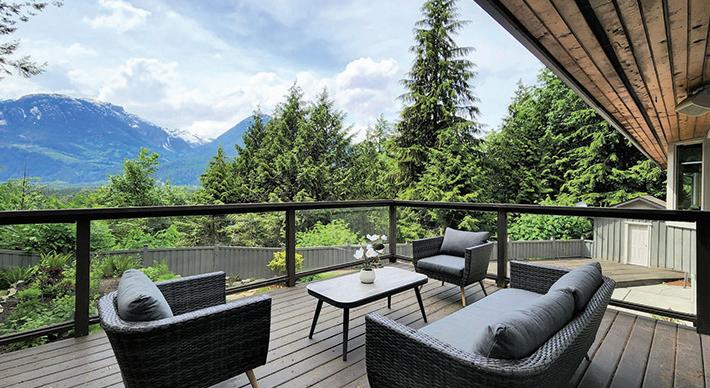



Maddi MacDonald 604-313-2029












